- A Beginner’s Guide to IELTS
- Common Grammar Mistakes [for IELTS Writing Candidates]

Writing Correction Service
- Free IELTS Resources
- Practice Speaking Test
Select Page
How to Describe a Bar Chart [IELTS Writing Task 1]
Posted by David S. Wills | Apr 13, 2020 | IELTS Tips , Writing | 5
There are various kinds of diagrams and charts that you may be asked to describe in the IELTS writing test, and one of those is the bar chart . In today’s lesson, I want to share some important advice that can help you improve your writing performance in your next IELTS test.
Describing data for task 1 of the IELTS writing exam is quite difficult and it will vary according to what you actually see. In other words, it is hard to simply teach some language for describing bar charts… Instead, your language will vary according to what the bar chart shows.
However, in this article I am going to break the process down and show you some examples so that you can understand it fully. At the end, I will give you a sample band 9 answer for a really difficult bar chart about people’s weight.
What are Bar Charts?
First of all, let’s start with the most basic question. You can feel free to skip this if you are already totally familiar with it. 😁 What is a bar chart? Basically, it is a visual representation of data using bars, like these:
Bar charts are used to show the difference between volumes or quantities of things because it is easy for the human eye to interpret. Let’s take a look at this example bar chart. I just found it on Google and will use it because it is simple. This is not a real IELTS chart. 🤪
You can easily see what this means. The most common excuse is “I forgot to set my alarm” and the least common is “It was still too dark; I thought it was still night-time.”
That is the purpose of a bar chart. It shows data in a way that is really easy for people to understand. As such, you may encounter it in your IELTS test. In that case, you will have to pick out the most important data and describe it.
Bar Charts for IELTS Writing
As we have seen, a bar chart is just another way of expressing data. For task 1 of the IELTS writing test, you may be asked to write about a bar chart. You will have to write more than 150 words and it is recommended that you do this in 20 minutes or less. (You will have a total of 1 hour for 2 tasks.)
It is important to note that you do not have to describe everything in the chart . Part of the task is picking out and describing only the relevant details. That usually means:
- The highest
- Major differences
- Anything interesting
What does that mean? This is very subjective, and so it is certainly open to debate. Let’s look at an example in order to understand it better:
In this bar chart, our eyes are naturally drawn towards the highest and lowest figures. The highest was in Sweden in 2012 and the lowest was in Finland in 2012. Therefore, both the highest and lowest figures occurred in the same year. That’s interesting!😅
Another interesting factor is that, in every year except one, Sweden had a higher divorce rate than Finland. It was only in 2015 that Finland’s divorce rate was higher than Sweden’s.
The Process
When you need to describe a bar chart for IELTS, you should take the same basic process as for describing anything else:
- Take time to read the question carefully.
- Look at the data and make sure you understand it.
- Find important data to describe.
- Plan your essay structure.
- Write your essay carefully.
- Check your answer for mistakes.
If you follow this basic routine, you will have a good chance of providing a strong answer to the question.
Language for Describing Bar Charts
In the past, I have talked about the language required to describe the following IELTS writing task 1 assignments:
- Process diagram
Bar charts are a little different because the language you would use depends on what is being described and there is no common set language that you would use just to talk about bar charts in general.
In the previous example, we can see that the bar chart features changing data over time. In such cases, we can use relatively similar language to that which we used for line graphs. You could say, for example:
Divorce rates in Sweden peaked in 2012 at a little under 50%, but fell in each of the subsequent years.
However, you can see that in the first bar chart there was no progression of time, so you cannot use language that shows changes in data. This brings us to the next stage…
Common Problems in Describing Bar Charts for IELTS
I used to teach writing skills at a university in China, and one of the most common problems I would have was teaching my students to write about bar charts. They could describe line graphs really easily, but the problem was that they would use the same expressions and structures for bar charts, when in fact something different was needed. Let’s look at two example charts. These contain similar data but there is an essential difference:
You can see that the line graph talks about changing phone prices over time, whereas the bar chart shows the different prices of phones. These prices are all taken from the same point in time .
Therefore, in order to adequately describe these, you must show that you understand the data.
For the line graph, you can say:
The price of Phone A rose from £380 to £410 between December and January.
However, you cannot use this language for the bar chart:
INCORRECT: The price rose from £380 for Phone B to £410 for Phone C. CORRECT: Phone C cost £30 more than Phone B, which cost £380.
This may seem easy to some people, but it is an important distinction and a common mistake. You should practice often to make sure that you know the difference.
Task 1 Essay Structure
There is no single perfect essay structure for IELTS, but there are some that are better than others. For task 1, I generally recommend writing an essay like this:
Let me explain what I mean by that.
It is really important to group your data appropriately. This can be quite difficult, so you should read this article first.
Essentially, you need to choose how to put groups of data together. Let’s take another example:
The chart below shows the total number of minutes (in billions) of telephone call in the UK, divided into three categories, from 1995-2002. Summarise the information by selecting a reporting the main features, and make comparisons where relevant.
For this sort of bar chart, you might choose to write two or three body paragraphs. Perhaps you would describe local fixed line phones first, then start a new paragraph for national and international ones, with another paragraph for mobiles.
Another way would be to break the data in half – one paragraph for 1995 to 1998 and another paragraph for 1999 to 2002.
There are lots of different ways. The only really important thing is that you make it clear to your reader why you have chosen to group the data this way. In other words, it must be logical .
Sample Answer
My answer to this question would look something like this:
The bar chart shows the time spent on three different kinds of phone calls in the United Kingdom over a period of eight years, starting in 1995 and ending in 2002. Local calls were the most common type of phone call made during the entire period, although both national/international and mobile calls grew in popularity to narrow the gap between these three types of call by 2002. In 1995, local calls were by far the most common type of phone call in the UK, with more than 70 billion minutes recorded on this chart. This is about double the amount of time spent on national and international calls, and more than ten times as much as was spent on mobile phone calls. All three types of phone calls grew in popularity until 1999, after which local calls decreased year-on-year until they ended the period at around the same figure as they began it – 70 billion minutes. National and international calls grew steadily over the recorded eight years, from about half the popularity of local calls to only slightly less in 2002. Mobile phone calls, however, grew ten-fold from about four billion minutes to more than forty billion.
A Really Difficult Bar Chart
Finally, let’s look at a difficult bar chart in order to show how we can tackle challenging problems.
As you can see, the first problem is that there are two charts! Already, that will prove more difficult than describing just one chart.
Another issue is that these bars look strange. They are all the same size… Why? Well, these represent the population. Each one is 100%, with the colours making up the different weight categories. The total can never be more than 100% because that it is the full population.
Now, you should try to interpret the data. What are the main changes?
- In 1955, there are lots of people at an ideal weight and very few people are obese.
- In 2015, many older people are obese. Fewer people are at an ideal weight.
- The weight distribution was similar regardless of age in 1955, but in 2015 it is very different.
Once you have picked out the important data, you should figure out how to structure your answer. I will use this structure:
However, I will make sure that there are clear comparisons between the 1955 and 2015 data. It is not enough to describe them in isolation.
Language for Talking about Age and Weight
To be honest, the hardest part of this bar chart is not that data but the terminology around age and weight. You can see from the chart that were are looking at age groups and weight groups. Many native speakers find this really difficult to talk about.
When we talk about age and weight, we usually say some form of “to be” rather than “to have.” For example:
- INCORRECT: In 2015, a higher percentage of people had overweight or obesity than in any other group.
- CORRECT: In 2015, a higher percentage of people were overweight or obese than in any other group.
- INCORRECT: In both years, the people who were most likely to be an ideal weight had 20 to 29 years.
- CORRECT: In both years, the people who were most likely to be an ideal weight were aged 20 to 29 years.
You can see how I explained this to one of the students on my writing correction service :
There are also problems with grouping people according to age. We can just say “people in the ___ age group/category” but this becomes repetitive after a while, so we need to use different language.
Talking about age is difficult, especially when describing groups of people who fall into different age categories. One thing to know is that, when you say use numbers, it is a sort of adjective and thus you need a noun to follow it or else it is meaningless:
- The criminals arrested were all 16 to 25 years old.
- I saw a 15-year-old boy running away.
You can turn the “old” into a noun by adding an “-s”:
- There was an increase of 25% in the unemployment rate for 20-29-year olds.
You can also put “aged” before the numbers:
- Most of the recipients were aged 18-22.
Sample Band 9 Answer
Here is my description of the bar chart above:
There are two bar charts showing the distribution of weight categories for people living in Charlestown. The first one is from 1955 and the second is from 2015. It is clear that vast changes have occurred in people’s health during this sixty year period. In 1955, very few people were overweight or obese, and most were healthy or even underweight. In each of the age groups, at least half of people were classified as in the ideal weight range, but towards the ends of the spectrum – the youngest and the oldest people – there were more people who fell into the underweight bracket. Being overweight or obese was a problem primarily affecting middle aged people, but not the most elderly ones. However, this distribution had completely changed by 2015. Although some young adults and elderly people remained underweight, a very slim number in the middle of the age groups did. Being overweight had become increasingly common, and obesity had become a huge issue, affecting people more and more as they got older. For people aged fifty and older, more than half suffered from obesity, and very few fell into a healthy weight range.
Useful Language
I will excerpt some of the useful phrases that appeared in this answer so that you can see how I have managed to describe ages and weights:
- very few people were overweight or obese
- most were healthy or even underweight
- at least half of people were classified as in the ideal weight range
- people who fell into the underweight bracket
- Being overweight or obese was a problem
- elderly people remained underweight
- Being overweight had become increasingly common
- obesity had become a huge issue
- more than half suffered from obesity
- very few fell into a healthy weight range
This was a really difficult bar chart to describe, but using this language I have managed to do it accurately and comprehensively.
Improve your Writing
If you want to get better at IELTS writing, the only way to ensure constant progress is by having an expert give you feedback. Most of the writing correction services that you find online are rubbish. They are run by people do not speak much English or do not understand IELTS. My writing correction service is one of the few that is truly worthwhile. I can tell you all your problems and help you to fix them.
Here is my feedback to someone who wrote an essay about the Charlestown weight distribution bar charts:
Let me know in the comment section if you have any questions. 🙂
About The Author
David S. Wills
David S. Wills is the author of Scientologist! William S. Burroughs and the 'Weird Cult' and the founder/editor of Beatdom literary journal. He lives and works in rural Cambodia and loves to travel. He has worked as an IELTS tutor since 2010, has completed both TEFL and CELTA courses, and has a certificate from Cambridge for Teaching Writing. David has worked in many different countries, and for several years designed a writing course for the University of Worcester. In 2018, he wrote the popular IELTS handbook, Grammar for IELTS Writing and he has since written two other books about IELTS. His other IELTS website is called IELTS Teaching.
Related Posts
How to Easily Double Your Task 1 Vocabulary
May 17, 2017
10 Amazing Tricks You Should Know When Learning another Language
December 28, 2017
4 Easy Ways to Improve Your IELTS Writing
June 4, 2017
Describe a TV Programme [IELTS Speaking]
February 22, 2021
Hi, David. I noticed that you didn’t include any figures at all in your sample answer for the weight assessment. Is that acceptable? This is because I have seen some IETLS teacher who taught us to include most of important figures. Thank you.
The important thing about IELTS is that it is an English test, so you should use your language to describe the data. Most candidates attempt to cram lots of numbers in so that they can use fewer words. The fewer numbers you use, the better. Sure, you can have one or two, but if you are able to use words to describe trends, reflect important data, or make comparisons, then it is much better. If you read my essay carefully, you will notice that I said things like “at least half of people” rather than just repeating numbers. This is a good strategy, although you can certainly put in a few numbers if you want.
Hi David. Thank you for your explanation. I have a question! for describing a chart what verb tens we should use? It depends on something or it has a rule! Thank you.
It depends on the situation. Pay attention to any time frame that is given or the origin of the data. If none is given, then present simple is fine.
Asalam O Alakum David
Can we explain only things in overview except figures, percentage and time trend? I mean only what they have mentioned in the picture.
Secondly, in last 2 paragraphs only should we write those things which they have showed in the graph, chart or map in a simple way.\
Please, confirm me.
With regards
Leave a reply Cancel reply
Your email address will not be published. Required fields are marked *
This site uses Akismet to reduce spam. Learn how your comment data is processed .
Download my IELTS Books
Recent Posts
- Past Simple vs Past Perfect
- Complex Sentences
- How to Score Band 9 [Video Lesson]
- Taxing Fast Food: Model IELTS Essay
- Airport Vocabulary
Recent Comments
- Daisey Lachut on IELTS Discussion Essays [Discuss Both Views/Sides]
- David S. Wills on Describe a Historical Period
- Siavash on Describe a Historical Period
- fabliha on IELTS Speaking Partners
- tufail khan on IELTS Discussion Essays [Discuss Both Views/Sides]
- Lesson Plans
- Model Essays
- TED Video Lessons
- Weekly Roundup
- Ebooks & Courses
- Practice Tests
How To Write an IELTS Bar Chart Essay
There are 5 steps to writing a good IELTS bar chart essay:
1) Analyse the question
2) Identify the main features
3) Write an introduction
4) Write an overview
5) Write the details paragraphs
Use this simple planning process as you practice writing IELTS bar chart essays and you’ll have no problem remembering it in the exam.
Steps 1 and 2 of the planning process should take around 5 minutes. It is essential that you don’t miss these out as they are the key to writing a high-scoring essay.
On this page, I’m going to take you through the whole planning process step-by-step as we work on a practice question.
Before we begin, here’s a model essay structure that you can use as a guideline for all IELTS Academic Task 1 questions.
Ideally, your essay should have 4 paragraphs:
Paragraph 1 – Introduction
Paragraph 2 – Overview
Paragraph 3 – 1 st main feature
Paragraph 4 – 2 nd main feature
Now that we have all these tools we need, we’re ready to begin planning and writing our IELTS bar chart essay.
Here’s our practice question:
The bar chart below shows the sector contributions to India’s gross domestic product from 1960 to 2000.
Summarise the information by selecting and reporting the main features, and make comparisons where relevant.
Write at least 150 words.
Contribution as % of India's GDP
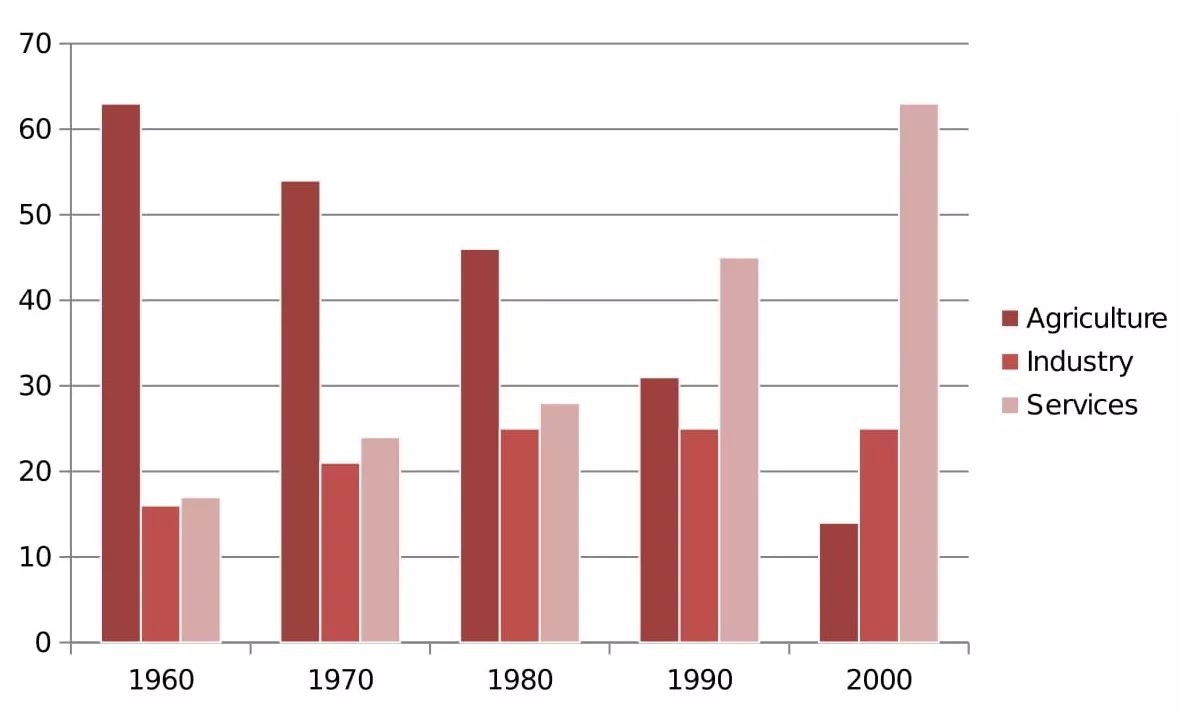
Source: EPW Research Foundation
Step 1 – Analyse the question
The format of every Academic Task 1 question is the same. Here is our practice question again with the words that will be included in all questions highlighted .
The bar chart below shows the sector contributions to India’s gross domestic product from 1960 to 2000.
Every question consists of:
- Sentence 1 – A brief description of the graphic
- Sentence 2 – The instructions
- The graphic – chart, graph, table, etc.
Sentence 2 tells you what you have to do.
You must do 3 things:
1. Select the main features.
2. Write about the main features.
3. Compare the main features.
All three tasks refer to the ‘ main features ’ of the graphic. You do not have to write about everything. Just pick out 2 or 3 key features and you’ll have plenty to write about.
Our practice graphic is a dynamic bar chart. That is, it includes a timeline giving data from several different points in time.
So, for this question, we need to identify the main trends (that is, the general developments or changes in situation) in the three key sectors of the Indian economy – agriculture, industry and service – between 1960 and 2000.
Alternatively, a bar chart may be static with the data coming from one point in time, as in the example below. For this graphic, we would need to compare the different variables, that is, the different leisure activities favoured by Canadian boys and girls.
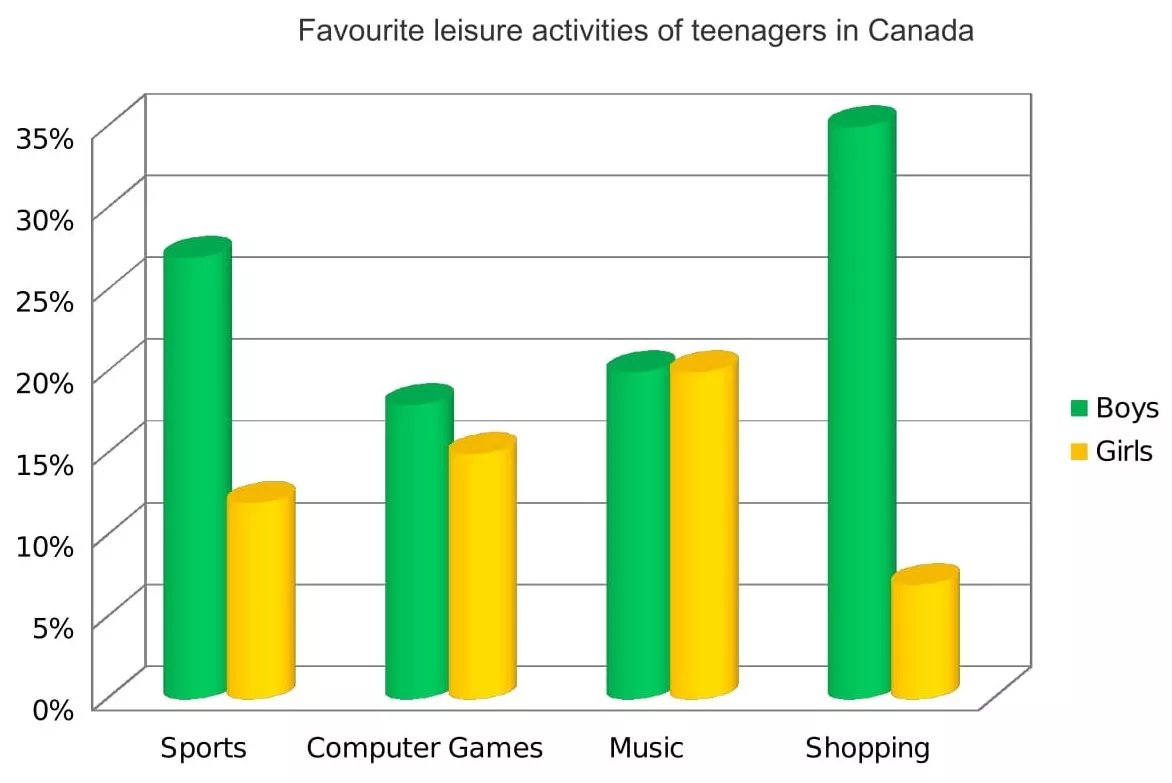
Step 2 – Identify the Main Features
The graphic in IELTS bar chart questions should not be difficult to interpret. Each question has been created to test your language skills, not your mathematics ability.
All you are looking for are the main features. These will usually be the easiest things to spot. As we’ve just seen, the type of key features will depend on whether the bar chart is dynamic or static.
There will be lots of information in the graphic to help you identify them. Here are some useful questions to ask?
- What information do the 2 axes give?
- Is it dynamic or static?
- What are the units of measurements?
- What are the time periods?
- What can you learn from the title and any labels?
- What is the most obvious trend?
- Are there any notable similarities?
(I give more detail on how to use these questions, plus downloadable checklists for identifying the main features of all 7 different types of IELTS Academic Writing Task 1 questions, in the lesson on How To Understand & Analyse Task 1 Questions .)
So, what main features stand out in our practice graphic?
Here's our practice IELTS bar chart again.

There are 3 main features/trends in this IELTS bar chart:
Main feature 1: The contribution of the agricultural sector dropped steadily.
Main feature 2: The contribution of the service sector increased each decade.
Main feature 3: Industry remained static from 1980 to 2000.
The general trends you select will be the starting point for your essay. You will then go on to add more detail.
With just 20 minutes allowed for Task 1, and a requirement of only 150 words, you won't be able to include many details.
We’re now ready to begin writing our essay. Here’s a reminder of the 4 part structure we’re going to use.
Step 3 – Write an Introduction
In the introduction, you should simply paraphrase the question, that is, say the same thing in a different way. You can do this by using synonyms and changing the sentence structure. For example:
Introduction (Paragraph 1):
The bar graph illustrates the relative percentage contributions made by the agricultural, industrial and service sectors to the Indian economy between 1960 and 2000.
This is all you need to do for the introduction.
Ideally, key words such as ‘sector’ and ‘contributions’ should be replaced by synonyms but there aren’t any obvious words that could be used instead so it’s fine to repeat them. It’s important that your language sounds natural so never try to force in synonyms that don’t quite fit.
Step 4 – Write an Overview (Paragraph 2)
In the second paragraph, you should report the main features you can see in the graph, giving only general information. The detail comes later in the essay. You should also make any clear comparisons you spot.
This is where we write about the general trends. Here are the ones we picked out above.
Now form these ideas into two or three sentences with a total of around 40 words. State the information simply using synonyms where possible. No elaborate vocabulary or grammar structures are required, just the appropriate words and correct verb tenses.
For example:
Overview (Paragraph 2) :
Over the whole time period, the significance of agriculture declined steadily while services grew in importance decade by decade. A different patterned emerged for industry, which initially showed a slowly increasing percentage but then plateaued from 1980 onwards.
Step 5 – Write the 1st Detail Paragraph
Paragraphs 3 and 4 of your IELTS bar chart essay are where you include more detailed information about the data in the graphic. In paragraph 3, you should give evidence to support your first 1 or 2 key features. Don’t forget to make comparisons when relevant.
Here are our first 2 main features again:
And this is an example of what you could write:
Paragraph 3 :
In 1960, agriculture contributed by far the highest percentage of GDP, peaking at 62%, but it then dropped in steady increments to a low of 12% in 2000. The service sector, on the other hand, had a relatively minor impact on the economy in 1960. This situation changed gradually at first, then its percentage contribution jumped from 28% to 43% between 1980 and 1990. By 2000 it matched the high point reached by agriculture in 1960, showing a reversal in the overall trend.
Step 6 – Write the 2nd Detail Paragraph
For the fourth and final paragraph, you do the same thing for your remaining feature/s. We have one main feature left to write about.
Here’s an example of what you could write:
Paragraph 4 :
Industry remained a steady contributor to India’s wealth throughout the period. As a sector, it grew marginally from 16% in 1960 to exactly a quarter in 1980 then remained static for the next two decades, maintaining a constant share of the overall GDP.
Here are the four paragraphs brought together to create our finished essay.
Finished IELTS Bar Chart Essay
(188 words)
This sample IELTS bar chart essay is well over the minimum word limit so you can see that you don’t have space to include very much detail at all. That’s why it is essential to select just a couple of main features to write about.
Now use what you’ve learnt in this lesson to practice answering other IELTS bar chart questions. Start slowly at first and keep practicing until you can plan and write a complete essay in around 20 minutes.
Want to watch and listen to this lesson?
Click on this video.
Would you prefer to share this page with others by linking to it?
- Click on the HTML link code below.
- Copy and paste it, adding a note of your own, into your blog, a Web page, forums, a blog comment, your Facebook account, or anywhere that someone would find this page valuable.
Like this page?
Ielts academic writing task 1 – all lessons.
IELTS Academic Writing – A summary of the test including important facts, test format & assessment.
Academic Writing Task 1 – The format, the 7 question types & sample questions, assessment & marking criteria. All the key information you need to know.
Understanding Task 1 Questions – How to quickly and easily analyse and understand IELTS Writing Task 2 questions.
How To Plan a Task 1 Essay – Discover 3 reasons why you must plan, the 4 simple steps of essay planning and learn a simple 4 part essay structure.
Vocabulary for Task 1 Essays – Learn key vocabulary for a high-scoring essay. Word lists & a downloadable PDF.
Grammar for Task 1 Essays – Essential grammar for Task 1 Academic essays including, verb tenses, key sentence structures, articles & prepositions.
The 7 Question Types:
Click the links below for a step-by-step lesson on each type of Task 1 question.
- Table Chart
- Process Diagram
- Multiple Graphs
- IELTS Writing
- IELTS Bar Chart
- Back To Top
* New * Grammar For IELTS Ebooks

$9.99 each Full Set Just $ 23.97
Find Out More >>
IELTS Courses

Full details...

IELTS Writing Ebook

Discount Offer
$7 each Full Set Just $ 21

Find out more >>
Testimonials
“I am very excited to have found such fabulous and detailed content. I commend your good work.” Jose M.
“Thanks for the amazing videos. These are ‘to the point’, short videos, beautifully explained with practical examples." Adari J.
"Hi Jacky, I bought a listening book from you this morning. You know what? I’m 100% satisfied. It’s super helpful. If I’d had the chance to read this book 7 years ago, my job would be very different now." Loi H.
"Hi Jacky, I recently got my IELTS results and I was pleased to discover that I got an 8.5 score. I'm firmly convinced your website and your videos played a strategic role in my preparation. I was able to improve my writing skills thanks to the effective method you provide. I also only relied on your tips regarding the reading section and I was able to get a 9! Thank you very much." Giano
“After listening to your videos, I knew I had to ditch every other IELTS tutor I'd been listening to. Your explanations are clear and easy to understand. Anyways, I took the test a few weeks ago and my result came back: Speaking 7, listening 9, Reading 8.5 and Writing 7 with an average band score of 8. Thanks, IELTS Jacky." Laide Z.
Contact
About Me
Site Map
Privacy Policy
Disclaimer
IELTS changes lives.
Let's work together so it changes yours too.
Copyright © 2024 IELT Jacky
All Right Reserved
IELTS is a registered trademark of the University of Cambridge, the British Council, and IDP Education Australia. This site and its owners are not affiliated, approved or endorsed by the University of Cambridge ESOL, the British Council, and IDP Education Australia.
IELTS Mentor "IELTS Preparation & Sample Answer"
- Skip to content
- Jump to main navigation and login
Nav view search
- IELTS Sample
- IELTS Bar Graph
IELTS Academic writing task 1 - Bar Graph
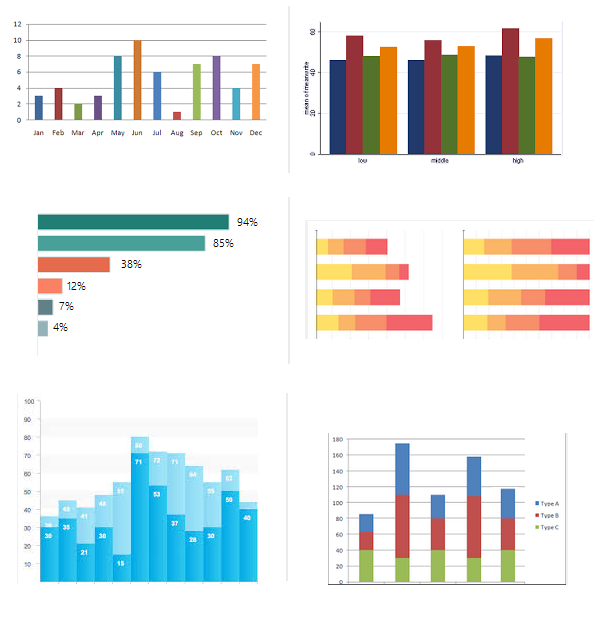
- Academic Writing Task 1
IELTS Materials
- IELTS Line Graph
- IELTS Table Chart
- IELTS Flow Chart
- IELTS Pie Chart
- IELTS Letter Writing
- IELTS Essay
- Academic Reading
Useful Links
- IELTS Secrets
- Band Score Calculator
- Exam Specific Tips
- Useful Websites
- IELTS Preparation Tips
- Academic Reading Tips
- Academic Writing Tips
- GT Writing Tips
- Listening Tips
- Speaking Tips
- IELTS Grammar Review
- IELTS Vocabulary
- IELTS Cue Cards
- IELTS Life Skills
- Letter Types

- Privacy Policy
- Cookie Policy
- Copyright Notice
- HTML Sitemap
- TOEFL Writing Correction Topics
- OET Course & Mock Test
- Writing Correction
- Speaking Mock Test
- Reading Course
- Listening Practice Tests
- FREE Practice Tests
- OET Writing Correction
- OET Reading Course
- OET Speaking Mock Test
- TOEFL Writing Correction
- PTE Writing Correction
- OET Listening Practice Tests
- OET (Occupational English Test)
- PTE (Pearson Test of English)
- Academic Task 1
Bar Charts IELTS Writing Task 1 Guide & Practice
- Task 1 Guide
- Table & Bar
- Bar & Pie
- Table & Pie
- Compare Contrast
- Identifying Trends

Bar charts are a very common type of question on the IELTS writing task 1 academic paper. Read below for helpful tips and tricks, as well as example questions and a model answer.
Table of Contents
1.1 objective, 1.2 skills used, 2.1 sample question 1- horizontal bar chart, 2.2 sample question 2- vertical bar chart, 2.3 sample question 3- two bar charts presented, 3.1 introduction, 3.2 overview, 3.3 main body paragraphs.
- 4.1 Task Achievement
- 4.2 Coherence and Cohesion
- 4.3 Lexical Resource
- 4.4 Grammatical Range and Accuracy
5.1 Vocabulary for Accuracy
5.2 linking devices, 5.3 language for reference, 6.1 comparatives.
- 6.2 Advanced Comparative Forms
7.1 Model Answer Commentary
8.1 problem 1, 8.2 problem 2.
- Quiz- Check Your Understanding of IELTS Bar Charts
1. Question Overview
An IELTS writing bar chart, also known as a bar graph, is something you may encounter in writing task 1 of the IELTS academic exam . The writing section of the test lasts for 60 minutes in total, and you should dedicate 20 minutes of your time to task 1 . Writing task 1 is worth 40% of your overall score for the writing component.
IELTS External links
Also, read the following IELTS Report Writing Guides
- IELTS Bar Chart
- Line Graph IELTS
- Pie Chart for IELTS
- IELTS Academic Table
- IELTS Academic Process Diagram
- Maps for IELTS
- Combined - Table and Bar Chart
- Combined - Bar Chart and Pie Chart
- Combined - Table and Pie Chart
- IELTS Writing Task 1 Guide

The main aim of this task is to produce a minimum of 150-word report that interprets the data presented in a given chart. You need to summarise the main features of the chart, add relevant data/figures and make valid comparisons where relevant.
This part of this exam will test your ability to:
- Select and summarise the key features of a chart
- Identify trends in information
- Describe and compare data
- Produce a report using a formal register
2. IELTS Bar Chart Sample Questions
A bar chart presents data visually using rectangular bars. These bars can either occur horizontally or vertically. You may also be given two charts to summarise and contrast in one task. In writing task 1 of the IELTS academic exam, you will always be given a description of the chart as well as key information you need to understand the chart such as:
- A title and/or statement explaining the chart
- A key/legend that explains the colour coding of the chart
- A labelled vertical Y axis
- A labelled horizontal X axis
You should spend about 20 minutes on this task.
The graph below shows the number of international graduates from UK universities in 2000 and 2015.
Summarise the information by selecting and reporting the main features and make comparisons where relevant.
Write at least 150 words.
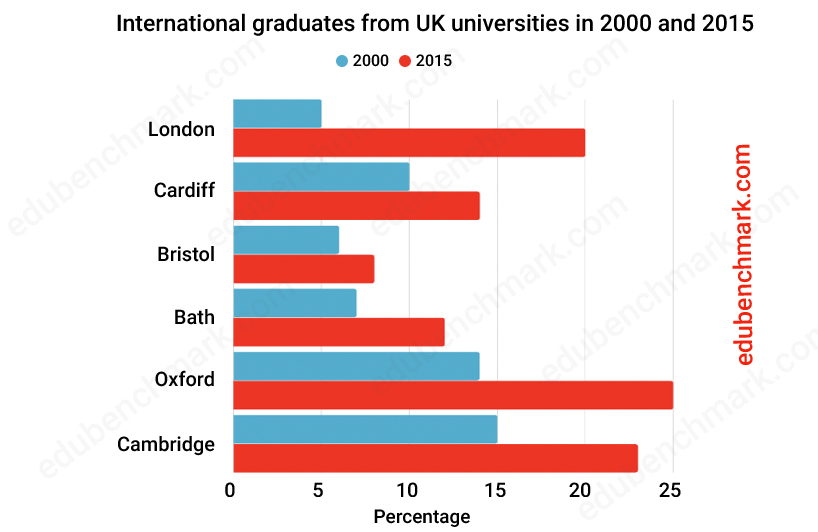
The graph below shows the changes in the maximum number of gorillas in the wild between 1990 and 2015.
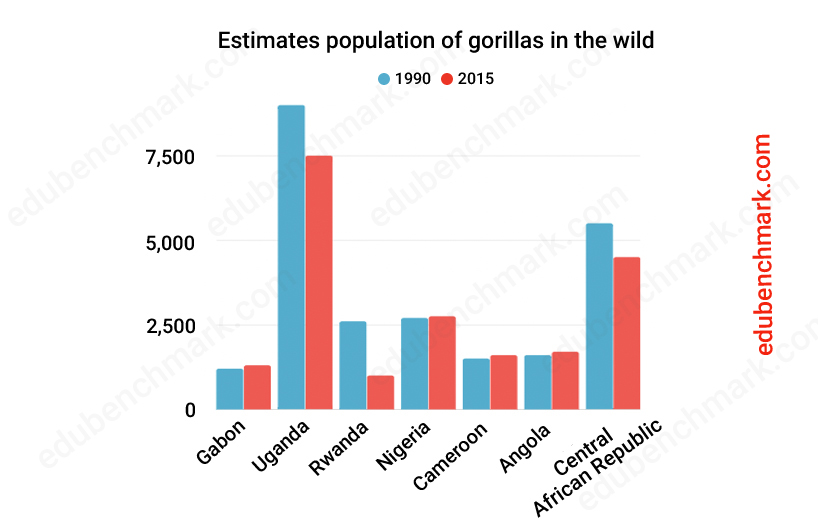
You should spend 20 minutes on this task.
The graphs below give information about computer ownership as a percentage of the population between 2000 and 2010, and by level of education for the years 2000 and 2010.
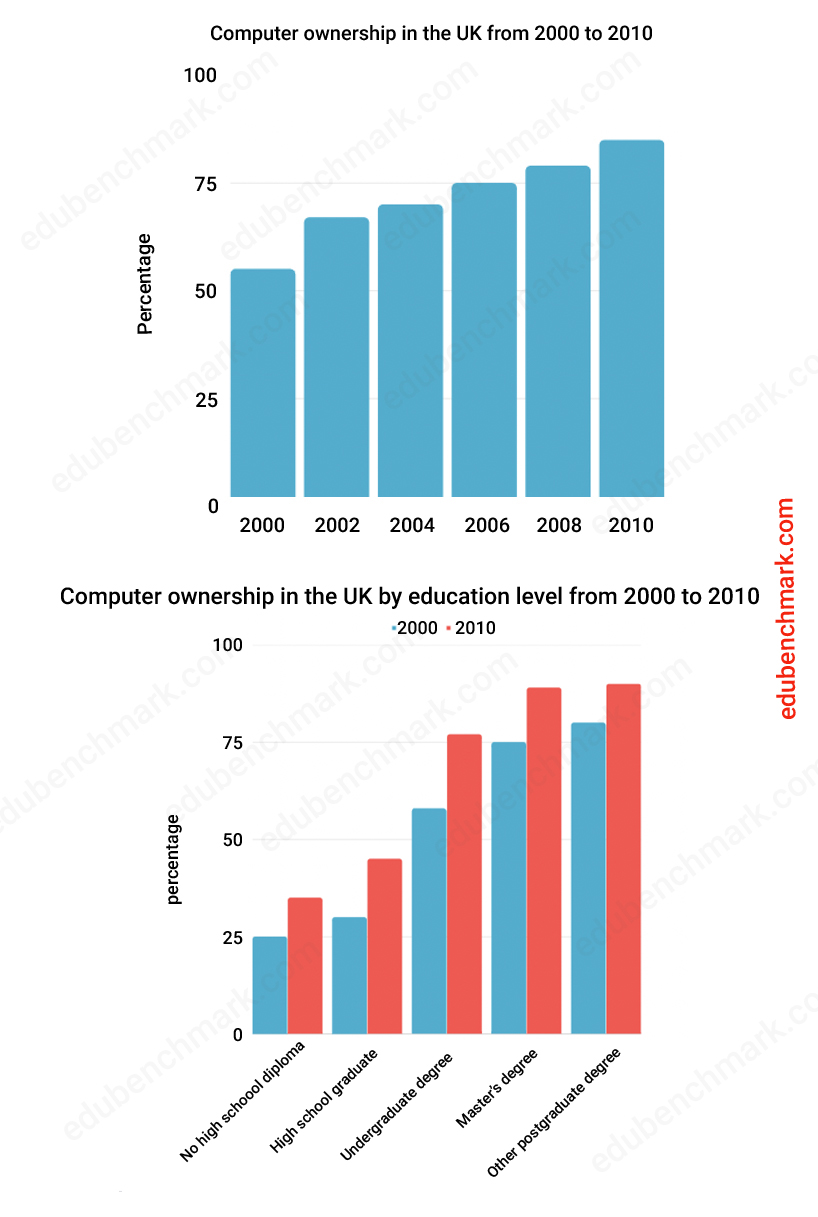
3. Structure for Bar Chart Reports
A good writing task 1 report will follow a very clear and logical structure with an introduction, an overview, and two main body paragraphs. Even though writing a conclusion is a good idea, it’s acceptable if you do not include a conclusion as the overview paragraph should suffice.
You can follow the same structure each time you practise writing reports. Follow the advice below for each paragraph below to start writing successful reports!
Your introduction should always paraphrase the given statement, meaning you should write it again in your own words. Memorising some good phrases to start a bar graph should help as well, but make sure the phrase you use is relevant to the given IELTS bar graph in the real exam. Let’s have a look at some examples below:
- The bar chart shows / presents
- The bar graph compares
Paraphrasing demonstrates to the examiner that you have fully understood the meaning of the writing task 1 statement and that you have the knowledge and understanding to be flexible with the language. The aim is to change the words and structure of the original statement whilst maintaining the meaning of the text. Successful paraphrasing may involve some of the following:
- Using synonyms/parallel expressions
- Changing the word order of the sentence
- Changing the phrase from active to passive
- Changing the form of words (e.g., noun to verb)
Example of paraphrasing
Original statement: The chart shows consumer spending on luxury goods in the UK in 2010 and 2020.
Paraphrased statement: The chart illustrates the amount of money spent on luxury goods (foreign holidays, high-end vehicles, designer clothes and spa services) by consumers in the United Kingdom in the years 2010 and 2020. Other things to consider when writing your introduction of a bar chart:
- You do not need to change every word to paraphrase a text successfully
- You may list given categories ( if the list is not too long). Use the word For instance, The bar graph presents wine production data in liters in three countries, namely Australia, New Zealand and Canada.
- Include any dates as this is important for tense
- Use brackets to put data and information inside
- Write 1-2 sentences maximum
- Look at the chart itself to see if there is any additional information to introduce not given in the statement
- This should be your most straightforward paragraph to write. Don’t spend too much time here and move onto your overview and main body paragraphs
Your aim in academic writing task 1 is to produce a ‘clear overview’ where you select and describe the main features/ trends from the bar chart. It is very important to include an overview paragraph for your writing task 1 response. The examiner will be looking for this and candidates who do not include an overview paragraph will be extremely difficult to score above a band score 5.0 in task achievement. More on IELTS Writing Band descriptors here.
You do not need to write a conclusion for task 1. A conclusion summarises the main ideas of a text. Your report is too short to do this, and you will end up repeating yourself which is something you want to avoid.
Typically, your overview should come directly after your introduction (recommended). However, you may find some sample reports where the overview comes at the end of the report.
Here are some key things to consider when writing your overview:
- Start your overview with ‘Overall’ to make it easy for the examiner to locate your overview paragraph. Other possible words / phrases are:
- It is clear from the graph that….
- Broadly, it can be seen that..
- There could be 2, 3, 4 or even 5 key features in your chart (we recommend you focus on 2-3)
- Your key features should stand out as the highest or overall figures in some way
- Make sure to use
- You should not give precise figures for your overview, save this for your main body paragraphs
You should have two main body paragraphs in your report to meet coherence and cohesion. Besides, this approach is logical and easy to follow for the reader.
There are different ways you could choose to organise your paragraphs depending on the data. For example:
Main Body Paragraph 1 – Compare the highest and lowest categories in the dataset
Main body paragraph 2 – Summarise and compare the other categories
The content of your body paragraphs will depend on the chart, but here are some general points to consider:
- Make sure to use the correct tense (look carefully at the given dates, are they in the past, present, future, or perhaps they range from the past to the predicted future)
- Determine if the chart is comparative or
- Always provide data and support your sentences with numbers
- Do not just provide a long list of numbers; the examiner will check every number and they need to be accurate and clear for the reader
- Use symbols given to you on the axis for currency, percentage etc. (e.g., £, $, %)
- Avoid repetition
4. IELTS Writing Task 1 Band Descriptors Explained
4.1 task achievement (25%).
To achieve a high band score in task achievement, you must:
- Produce a factual report (use a formal register; do not give your opinion; avoid the first person ‘I’)
- Write at least 150 words (you need to be able to sufficiently develop your ideas)
- Report and compare the key features of the chart (do not try to describe every detail of the chart)
- Provide an overview that clearly highlights the key features of the chart (this is essential to scoring above a band score 5 in task achievement)
- Accurately describe the data
4.2 Coherence and Cohesion (25%)
To achieve a high band score in Coherence and Cohesion of your bar chart task 1, you must:
- Organise your report logically
- Use paragraphs (include an introduction, an overview, and two main body paragraphs)
- Use a range of linking devices accurately and appropriately
- Use referencing effectively to avoid repetition (e.g., using ‘this’ to refer to refer back in your text to a noun/noun phrase)
4.3 Lexical Resource (25%)
To achieve a high band score in Lexical Resource of task 1 bar graph, you must:
- Use a range of vocabulary appropriate to describe data from bar charts
- Show understanding of collocations
- Avoid making spelling mistakes
- Use an appropriate register throughout the report (e.g., avoid slang/ phrasal verbs/ idioms)
4.4 Grammatical Range and Accuracy (25%)
To achieve a high band score in Grammatical Range and Accuracy, you must:
- Use the correct tense according to your data set (confirm if your data is taken from the past, present, future, or a combination, and use the corresponding tense in your report)
- Use a range of simple and complex sentences (e.g., compound, relative, or subordinate sentences)
- Avoid grammatical errors
- Use punctuation accurately
5. Vocabulary for IELTS Bar Charts
When describing bar graph IELTS task 1, you will often find that a figure cannot be precisely determined and you have to estimate the number. To show flexibility with your language, you can use words and phrases to estimate the figures. Here is some useful language to help you write about numbers that are above, below or approximate figures:
In order to create cohesion throughout your report, you should use a range of linking devices appropriately. Here are some useful linkers to create contrast when writing about bar charts:
- as opposed to
- compared to
Examples 80% of people owned a computer in 1990, whereas/while only 30% owned one in 1980.
Only 30% of people owned a computer in 1980 as opposed to/compared to 80% in 1990.
Using the words ‘ respectively ’ or ‘ in turn ’ is an efficient and accurate way to refer back to specific figures in your writing task 1 report. It will also help to avoid unnecessary repetition and improve your lexical resource score.
When using these terms, the order of the numbers follows the order in the sentence. You can also use brackets to contain the figures.
Examples The price of oil and gas in 1990 was almost the same (about $100 and $110, respectively ).
Espressos were considerably less popular than espressos , at 4 and 8 sales per week in turn .
6. Grammar for Bar Charts IELTS Task 1
You can use comparative structures to improve your range of grammar and compare the data in the bar chart/s. For example:
You can also use words together with comparative forms to indicate a small or a big difference:
- considerably
Examples: Americanos were considerably more popular than espressos.
Cappuccinos were slightly more popular than caramel lattes.
6.2 Superlatives
Superlatives are a useful way to rank or order information.
- Travelling by plane is the most expensive way to travel, at an average of £100 per ticket.
- The second most expensive is by train, where it costs around £30.
- The least expensive form of transport is by bus, coming in at £20 per ticket.
6.3 Advanced Comparisons
- X is not as + adjective + as y e.g., Coffee in Brazil is not as expensive as in America.
- Not + verb + as + noun phrase + as e.g., Coffee in Brazil does not cost as much as in America, at $2 and $2.90, respectively.
- Three times/ half/ twice as much/less as e.g., Coffee in America costs twice as much as in Brazil.
- The number of X is ___ times higher than Y e.g., The number of people buying coffee in Brazil is three times higher than in America.
7. IELTS Bar Graph Sample Answer
The chart shows data about the average weekly sales of two coffee shops in New York in 2015.

The bar chart compares the most popular types of coffee sold by two coffee shops in New York in a typical week in 2015. The chart shows average sales of eight items, including iced coffees, Americanos and espressos, in Club Coffee and Espresso Express.
Overall , it can be seen that Club Coffee is generally the busiest coffee shop, outselling Espresso Express in six out of eight coffee items. On the whole , stronger coffees such as espressos and flat whites were not as popular as weaker coffees like café lattes or cappuccinos.
In terms of sales at Club Coffee, café lattes came top of the list, with an average of around 135 sold each week. Cappuccinos and Americanos were the next best sellers, with around 115 and 100 of these drinks sold respectively. Club coffee sold slightly more decaf coffees than iced coffees, with roughly 75 of each in total being sold per week on average. Espressos and caramel lattes were not nearly as popular, with just 25 and 18 sold in turn.
Café lattes were also the number-one purchase in Espresso Express, with just over 120 average items sold in a week. Cappuccinos were third, at around 65 sales. Caramel lattes came next, with just over 60, three times as many as are sold in Club Coffee. Decaf coffees and flat whites were joint fifth, with 50 sales apiece, followed by iced coffees at approximately 45 sales a week. The least popular item in Espresso Express was espressos with around 25 sales.
The report above would receive an estimated 9.0 overall in the IELTS writing task 1 Academic paper.
It has been organised into four logical paragraphs that are clearly divided into an introduction, overview, and two separate body paragraphs.
The overview paragraph has been clearly signposted using ‘overall’ and a further linker ‘on the whole’. These key features have been compared concisely using phrases such as ‘stronger coffees… were not as popular as weaker coffees…’.
Further details have been given in the main body paragraphs. The data has been presented accurately using vocabulary to express when the figure cannot be exactly determined, such as ‘around’, ‘just over’ and ‘roughly’.
Comparative language has been used throughout the report through the use of comparatives and superlatives, for example, ‘the least popular item…’
Reference has been employed to reduce repetition , for instance ‘with just 25 and 18 sold in turn’ and ‘with around 115 and 100 of these drinks sold respectively’.
8. Common Errors and How to Avoid Them
Not understanding what information to include in your bar chart report.
Solution 1 Take a short amount of time, before you even start writing, to identify the key features of the chart. It will be worth investing this time in finding the highest, lowest or most interesting key features instead of wasting time trying to write about every detail
It is not common that you will be asked to describe a bar chart with a trend, this is more common with a line graph . Candidates often use language to describe trends when it is not appropriate. For example, the sentence ‘the price of X rose from £ ______ to £______ between 2000 and 2010’ is more suitable for a line graph with a trend, not a bar chart.
Solution 2 Ensure you understand the data clearly so you can use the appropriate grammar and vocabulary.
It is likely that a comparative form would be more appropriate instead of describing a change (rise/fall).
Incorrect for bar chart: The price of X rose from £ ______ to £______ between 2000 and 2010.
Correct for bar chart: X cost £____ more than Y, which cost £_____.
9. Quiz- Check Your Understanding
Take this short quiz to test your understanding of writing task 1 and bar charts:
Bar Charts- IELTS Writing Task 1
- The key/legend
- The IELTS statement
- The horizontal and vertical axis
- All of the above Answer: D.
Explanation: You must include an overview paragraph if you want to score higher than a band 5.0 in task achievement.
Explanation: You may see a vertical horizontal bar chart, or even two types of bar chart may be presented. You are likely to see a comparative bar chart, but occasionally IELTS do set bar charts that ask you to describe a trend (as you would with a line graph).
Explanation: To create a well organised report you should use four paragraphs: an introduction, an overview, and two main body paragraphs
Explanation: True, each section of the marking criteria is work 25% of your overall score
Explanation: Using the words ‘respectively’ or ‘in turn’ is an efficient and accurate way to refer back to specific figures in your report in the order they are mentioned. It will also help to avoid unnecessary repetition and improve your lexical resource score.
- The price of oil and gas in 1990 was almost the same ($100 and $110)
Explanation: Superlatives can help to create order, for example, travelling by plane is the most expensive way to travel, at an average of £100 per ticket. The second most expensive is by train, where it costs around £30.
- Comparatives
- Referring expressions
- Coffee in Brazil as expensive as in America.
- Coffee in Brazil is not expensive as in America.
Explanation: ‘not as _____ as ____’ is a useful comparative sentence that can broaden your grammatical range.
One thought on “Bar Charts IELTS Writing Task 1 Guide & Practice”
Leave a reply cancel reply.
Your email address will not be published. Required fields are marked *

- ielts writing
- ielts listening
- ielts speaking
- ielts reading
- ielts practice test
- IELTS Sample Reports
- IELTS Sample Essays
- IELTS Sample Letters
- IELTS Vocabulary
Exam Updates & Tips!
Signup for preparation and special offers!
You have successfully joined our subscriber list.
IELTS Writing Task 1: How to Describe a Bar Chart

If you’re not sure where to start, that’s ok! In this piece, we’ll provide an overview of how to describe a typical IELTS Writing Task 1 bar chart. We also suggest taking a look at resources in this piece on useful words for writing an IELTS Graph Essay
Table of Contents
What will you see in an ielts writing task 1 bar diagram, how to write about an ielts writing task 1 bar chart, how to describe an ielts writing task 1 bar chart, a final word on describing ielts academic bar charts.
A bar chart uses either horizontal or vertical bars to show comparisons among two or more categories. The bar chart has two main features: an X-axis and a Y-axis. One axis of the chart shows the specific categories being compared, and the other axis of the graph shows a given value (usually a percentage or a dollar amount).
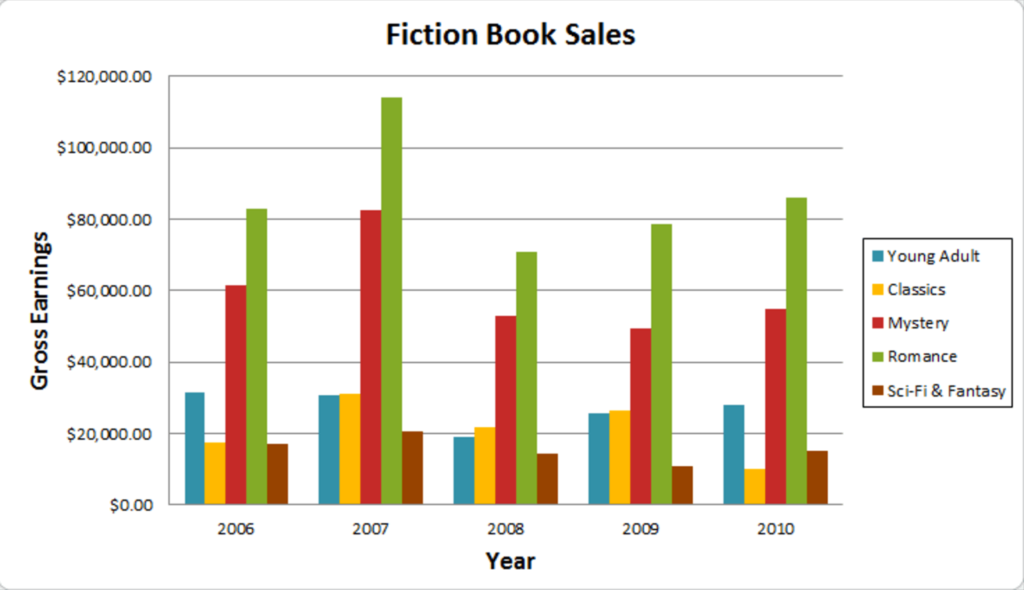
To effectively write about an IELTS Writing Task 1 bar chart, follow these tips.
1. Start by Reading the Title
First and foremost, you should read the title. Often, I have students report on the essay in an inverted order because they didn’t read the bar chart title.
For example, an IELTS Writing Task 1 bar chart that I give students has the chart title “Expected City Visits by Country of Origin for 2018.” Yet I often get sample sentences back that read: “It is predicted that people from France will be the most likely to visit the United States in 2018.” The correct answer should be “It is predicted that Americans will choose France as their favorite city to visit in 2018.”
2. Look at the Time Frame
Look at the given period of time covered in the chart. Are you looking at a specific year? Are there multiple years being compared? Are we talking about something in the future? This will determine your grammar and style to some extent. For example, whether you need to use past tense language, the language of change, or future tense language when discussing your data.
3. Decide What You Are Comparing
What titles are given to the Y- and X-axis? This important information will form the language that you will use in the essay and the corresponding synonyms you should also use.
For example, the bar chart above compares the gross earnings of fiction books in five categories (Young Adults, Classics, Mystery, Romance and Sci-Fi and Fantasy) between 2006 and 2010. (Incidentally, this sentence is exactly what you would say for your introduction!)
Now that you know what the IELTS Writing Task 1 bar chart is about, these are the vital elements to include in your essay:
- Start with an introduction. The introduction explains what the chart is about, and gives an overview of the main points. Make sure you include one! Your introduction can be short, but it must be there. If you’ve spent time examining the chart this should be easy to write.
- Look for the key data and make sure that you are comparing and contrasting the data, NOT just listing the data from one section to the next. If you just write about what happened to X, what happened to Y, and what happened to Z, without showing any relationship between them, you will not get a high score.
To do this, you will need to look for similarities and differences when you first analyze the chart and you will need to decide what can logically be put together or not. This means that you don’t have to describe everything that you see in the bar chart, just the key points!
For example, for the above chart, you might say: It is interesting to note that Romance novels earned the most income each year between 2006 and 2010 with sales ranging from $70,000 to $115,000. In contrast, Sci Fi and Fantasy novels were the poorest revenue generators of the five categories earning only $20,000 at its highest point in 2007 and a mere $10,000 at its lowest point in 2009.
- Group the data together so that you have a well-organized and coherent answer. It is a good idea to divide your answer into two or three paragraphs so it is well organized. To do this, you should group similar ideas together into paragraphs or sections. Cohesion and coherence are key!
- Use a wide variety of sentence structures. Include complex sentences and simple sentences.
- It is equally important to use appropriate transitions between describing each data point.
- Always provide a short summary conclusion of what you included in your essay. One line is enough here. For example, It can be seen from the chart that overall, 2007 was the best year for book sales in all five categories.
- Finally, make sure that your word count is 150.
Overall, describing a an IELTS academic bar chart is a pretty straightforward task on your exam. Remember that in order to write well about a bar chart, you’ll want to be very clear on the relationship being expressed in it, so be careful not to rush past this step.
That said, you won’t want to spend more than about 20 minutes on IELTS writing task 1, so save most of your time for essay writing.
We hope we answered all of your IELTS Writing Task 1 bar diagram and bar chart questions! For more advice, we recommend taking a look at this IELTS writing task 1 vocab guide .
Good luck on your IELTS writing test!

Eliot Friesen-Meyers is the Senior Curriculum Manager for Magoosh IELTS and TOEFL. He attended Goshen College (B.A.), New York University (M.A.), and Harvard University (M.T.S.), gaining experience and skills in curriculum development, ESOL instruction, online teaching and learning, and IELTS and TOEFL test prep education. Eliot’s teaching career started with Literacy Americorps in Pittsburgh, Pennsylvania, and later, taught ESL programs at Northeastern University, University of California-Irvine, and Harold Washington College. Eliot was also a speaker at the 2019 TESOL International Conference . With over 10 years of experience, he understands the challenges students face and loves helping them overcome those challenges. Come join Eliot on Youtube , Facebook , and Instagram . Recent blog posts Complete Guide to IELTS Writing Task 1 Complete Guide to IELTS Writing Task 2
View all posts
More from Magoosh

3 responses to “IELTS Writing Task 1: How to Describe a Bar Chart”
Thank you so much for your units and sharing.
We’re so glad we can help! 🙂
The bar chat illustrates the total amount of earning in sales of fiction books(young adults,classics,mystery,romance,sci-fi and fantasy) between 2096 and 2010. Overall,the total amount of sales of earning in romance book has highest through out the give decades while sci-fi and fantasy books has lowest amount of sales. In 2097 romance book earings has raised more than 10000000 respectively and then decreased to 9ne third in 2008 about 70,000,00 whereas the last two decades 2009 and 2010 upsurge arround 79,999,99 and 35,000,00 while the total gross earnings in the mystery books in 2006 arround 60,000,00 and increased in 2006 arround 82,000,00 has highest constant more than 40,000,00 same in 2009. On other hand,the total amount earings in young adults and classic book in 2007 and 2009 remains same about 25,000,00 meanwhile in 2006 and 2019 young adults books gross earnings has highest about 15,000,00 and 14,000,00 classic downsurge arround 99,999,99 however from 2006 to 2019 sci-fi and fantasy books earings has lowest sales less than 20,000,00 approximately.
Leave a Reply Cancel reply
Your email address will not be published. Required fields are marked *
- Skip to main content
IELTS Podcast
Pass IELTS with expert help.
How to score high on a bar graph question in writing task 1
The bar graph task 1 essay accounts for a third of your marks in the writing test so we recommend spending around 20 minutes on it, as this is a third of your time. There are a couple of different structures you can follow when describing an IELTS bar chart .
A strategy for bar graph questions
Essay structure, or how you organise your answer, is very important in academic writing. Today we will teach you a new method – a structure where you assign each sentence of your text to a topic – kind of the opposite of what you usually do when writing task 2 . It may look a little confusing, but this method really works! Just follow our lead for IELTS task 1.
Remember that bar chart and bar graph are synonyms and you can use the phrases interchangeably. Although each bar graph will be different, you are not required to be an expert on the information it shows, just to summarise the information, identify trends and make comparisons. Each bar graph IELTS question is different, so look at as many bar graph examples as you can and practice this strategy until you feel really confident.
How to choose information from the bar graph?
Assuming one sentence contains around 10 to 15 words, we can estimate that your description of the bar chart will consist of about 10 to 12 sentences. Now we can assign each sentence a specific task:
- One sentence for the introduction.
- Two sentences using superlatives.
- A sentence with a comparison. Make comparisons where relevant.
- A sentence grouping two data points to show similarity (for example, you might include a brief description showing a gradual decrease in two different areas).
- A sentence noting an exception to an overall trend.
- A sentence describing some data in an advanced manner, using complex sentence structure.
- A sentence describing relevant data using a simple structure.
- Two sentences for summary and conclusion.
Note that this method is quite flexible and these sentences don’t necessarily need to go in this particular order. You must write them in a way that makes your bar chart description flow naturally. Think about which sentences go together in each body paragraph as well as the introduction paragraph and conclusion. You may also have to repeat a few sentences using different data if you find your graphic contains more information or find a way to mention different groups in one sentence. The structure above is a rough guide to get you started. Once you have looked at the example and are comfortable with this structure, you can use this example as a model to describe different bar charts and answer as many bar graph questions as you can. Just remember to get feedback while you are testing your ideas otherwise, it’s quite difficult to improve.
A bar graph sample question and answer
Now that we have figured out what we want to write about in the description of the bar graph, it’s time to put our data selection skills to use and make comparisons where relevant. It is easy to get lost in all of the information provided by a bar chart as there can be so much data. That’s why it’s important to keep in mind what you are looking for when you are analyzing the chart.
The task achievement score for task 1 makes it clear that you need to answer all parts of the question – in other words, describe the main features AND compare them, in order to get a good score. Task achievement is 25% of your total marks so don’t forget to make comparisons! The first thing you should do is identify key features. Once you have decided on the main points, make note of any secondary features that will support the main features.
Ready for a high-level bar chart task 1 answer? Let’s begin with the analysis of this bar chart, and pick out the information that is relevant to our structure. See the model answer of a bar chart below.
Sample Answer Bar Graph Essay
The bar chart shows the caloric intake of UK males in three distinct age groups of 0-24, 25-49, and over 50 years old. The data is shown as percentages. Dairy for the 0-24 age group was the highest source of calories, whilst the other categories each represented about 20% each. In the next age group dairy fell to around a quarter, and meat became the main source of calories, reaching half of the total intake. Pulses and vegetables reached 10% and 15% respectively. Pulses in the final age group increased sixfold to over 60%, whereas calories obtained from vegetables was 10%, half that of meat (20%), and even slightly less than dairy (15%). The 50+ group shows the most marked preference out of all the groups. It also confirms the gradual decline in vegetable consumption as males become older. Overall it is clear that each age group has a clear favourite which varies depending on age. However, vegetables are consistently amongst the least popular, regardless of age.

Sample Answer Analysis
In this essay, the introduction paragraph restates the writing prompt. It is not the overview paragraph, which can be either the first or the last paragraph. In this case, the overview appears at the end in which the writer states the overall trends of the bar graph. While the horizontal axis contains information relating to the question keywords, it’s important not to overlook the vertical axis and state clearly how the data is given (for example, is it as percentages, in kilos, or tonnes, or hours?) Make sure you have included this information in the first part of the essay.
You will also notice that the body paragraphs consist of a breakdown of the main features in order of age group to show and compare the difference in amounts of each food category consumed as people grew older, placing the final age group into its own body paragraph. This is because the data showed that there was a fairly significant upward trend in one food type (pulses) that the writer wanted to highlight. And finally, as previously mentioned, the conclusion part of this essay includes the overview, which should consist of a sentence or two about general trends.
Some notes on structure
Notice how the sentence is structured. How many complex sentences can you identify? When preparing for your IELTS academic writing task, you will want to show some sophisticated writing. When you sit for your IELTS writing test, you might feel pressured for time and it may be a bit difficult to think of complex sentence structures while considering the main features. Take note on the following important tips on structure:
- Make sure you have mentioned all the categories in your answer – in this example, there are four categories.
- Make sure you have also included the correct values when you summarise the data, in this case, percentages.
- It is often tempting to write too much for a task 1 essay but by following the method shown you will stay focused. Concentrate on the most important information.
- Compare the highest and lowest values, for example, rather than all the differences.
- Write what comes naturally at first, even if you write in correct simple sentences.
- Allow yourself some time at the end to go back and adjust some of your structures to complex sentences.
- If you are aiming for a high score on the IELTS test, you should aim for structures that are complex and accurate.
- It is important to be sure of the tense you are using. This example requires the present tense but many bar charts illustrate data from the past. In that case, you need to write the introduction in the present tense (the bar chart illustrates…) and then switch to writing mostly in the past tense (the number of people choosing this option dropped after the first year).
Click here for more free IELTS bar chart sample essays . You can also find sample IELTS task 1 questions here .
Tips on describing a bar graph in IELTS
- Avoid listing every single data point; instead, use your own words to describe the key information from the chart/graph.
- Avoid mixing formats: for example, don’t mix decimals with estimations in the same sentence.
- Check whether there is a date on the bar chart – you may need to use the past tense.
- Make note of general trends, particularly upward or downward trends that can be highlighted in your own words.
- After you have successfully written out your description with all of the information you want to include, go over it and replace some simpler words with more academic vocabulary – this will help you achieve a high score . For example, try replacing “big” with “most significant”.
- Check that your text is error-free. Review carefully to see if all your sentences are grammatically correct.
- Make sure that the data you have described is correct – that you have not made a mistake with a category or labels.
- Review for the correct use of connectors and linking words .
- Practise with different bar graphs/pie charts to improve especially with a range of values (percentages, kilos, miles, dollars).
- Review the superlatives – highest, lowest, most expensive, biggest difference – these are essential if you want to effectively describe bar charts.
- The fastest way to improve is to get feedback on your work. You can also check another model bar graph answer for comparison.
- Don’t forget to check your word count. Make sure your piece is another too brief nor too wordy and detailed. Most model answers come in at around 200 words. You’ll use a similar writing model for pie charts and tables so you don’t need to memorise completely different models for each.
Bonus tips to score high on IELTS Bar Graph Questions
- To improve your task 1 bar graph skills try copying out a sample bar graph with pen and paper. You will start to understand how to locate key points and choose the most relevant information. It doesn’t matter what the topic is, remember it could be anything from the gross domestic product of different countries to comparing the highest expenditure on housing. You don’t need to be an expert on gross domestic product or the Japanese rental market, you just describe the data and make comparisons.
- Practice describing a bar chart out loud. It will help you remember vocabulary to describe data under pressure, decide point by point what to include in your answer and make sure you have mentioned every category at least once. Your confidence will improve when it comes to your next IELTS writing task.
- Make sure you practice ‘two type’ questions – you might see an IELTS question with one bar chart or two so it is a good idea to look at a model answer for each type. You might see one bar chart and a table, or other types of graphs such as line graphs. Some questions might have a mix, for example, one or more pie charts and a bar chart. However the data is displayed, it’s important to stay calm and focus on finding the major differences and similarities, compare categories and identify trends. Describing a table or line graph is very similar to describing bar charts and the more you practice the more confident you will feel.
Check out one of our free lessons here by clicking on the following link !
Video: How to describe a bar graph
Click here to subscribe to the Youtube channel.
Frequently Asked Questions (FAQs)
How to describe bar graph in ielts task 1.
Divide the information into two or three groups, focus on trends and exceptions to help you. You don’t need to describe everything. Think of synonyms for key words and most important numbers – for example, 52% is just over half.
How to write task 1 bar graph?
Follow a model, the 4 paragraph diagram model is easiest. That’s rephrasing the question, one main trend, another main trend and an overview. Overall have 10 sentences with specific tasks as we explain in this article.
How do you write a description of a bar graph?
Remember that the important thing is to describe the main features AND make comparisons. Use superlatives and the phrase ‘which means that…’ to help you. For example, Portugal’s spending was between 20 and 27% which means that it had the highest spending of all 4 countries studied.
Audio tutorial: How to describe a bar chart for the IELTS exam
| Download | Stitcher | iTunes | Android | RSS
Podcast: Play in new window
Sample Bar Chart Questions and Model Answers
Take a look at these bar chart model answers to help you prepare
- Bar chart of international student enrolment in British universities 2009-2014
- Bar chart of average monthly revenue from retail telecommunication subscribers
- Bar chart of increase in total consumption
- Bar chart of life expectancy (2006)
- Bar chart of percentage of eligible voters registered for each race by state and year
- Bar chart of average weekly attacks
- Bar chart of pet Owners
- IELTS Task 1 Sample Answer 2 Double Graph Pie Chart and Bar Chart
Podcast: Play in new window | Download
The official IELTS by IDP app is here! Download it today.
- Bài thi IELTS IELTS Academic IELTS General Training IELTS UKVI IELTS One Skill Retake Tìm hiểu bài thi IELTS Học Thuật là gì? Tìm địa điểm thi IELTS trên giấy Tìm địa điểm thi IELTS trên máy tính Đổi lịch thi hoặc hủy thi IELTS Hình thức thi IELTS Academic Thi IELTS trên giấy Thi IELTS trên máy tính Tìm hiểu bài thi IELTS Tổng Quát là gì? Tìm địa điểm thi IELTS trên giấy Tìm địa điểm thi IELTS trên máy tính Đổi lịch thi hoặc hủy thi IELTS Hình thức thi IELTS General Training Thi IELTS trên giấy Thi IELTS trên máy tính Tìm hiểu bài thi IELTS UKVI là gì? Tìm địa điểm thi IELTS trên giấy Tìm địa điểm thi IELTS trên máy tính Đổi lịch thi hoặc hủy thi IELTS Hình thức thi IELTS UKVI Thi IELTS trên giấy Thi IELTS trên máy tính LEARN ABOUT THIS TEST What is IELTS One Skill Retake? Hướng dẫn đăng ký thi IELTS OSR Đổi lịch thi hoặc hủy thi IELTS ĐỌC THÊM VỀ IELTS ONE SKILL RETAKE Các tổ chức chấp nhận IELTS One Skill Retake Cách sử dụng kết quả IELTS One Skill Retake Câu hỏi thường gặp IELTS One Skill Retake Đăng ký thi IELTS Lịch thi IELTS Lệ phí thi IELTS Chương trình ưu đãi IELTS Tìm địa điểm thi IELTS
Get your results
Check your provisional IELTS results online and do more.
- Simplified Chinese

Cách viết Writing Task 1 dạng Bar chart chỉ với 3 bước cực hiệu quả
Cách viết dạng Bar chart trong Writing Task 1 được IDP cập nhật chi tiết trong bài viết sau! Hãy cùng theo dõi ngay để biết cách phân tích đề bài, lên outline và triển khai từng phần cho dạng câu hỏi nhận xét biểu đồ cột trong IELTS.
Chủ đề bài viết
Bar chart - Biểu đồ cột IELTS thể hiện sự biến thiên của đối tượng (dựa trên một đơn vị nhất định). Dạng bài này thường yêu cầu phân tích đặc điểm, số liệu, so sánh và dự đoán xu hướng của đối tượng. Có hai dạng là Bar chart có sự thay đổi theo thời gian (time graph) và không có sự thay đổi theo thời gian (comparison graph) với đặc điểm và cách làm khác nhau. Dưới đây là cách viết biểu đồ cột trong IELTS , cùng theo dõi ngay!
>>>Xem thêm: Thi ielts bao nhiêu tiền và cách thanh toán chi phí thi IELTS tại IDP
Bước 1: Phân tích biểu đồ
Bước đầu tiên khi sau khi đọc đề bài đó là phân tích biểu đồ. Mỗi đề bài sẽ bao gồm ba phần:
Phần 1: Mô tả ngắn gọn về biểu đồ “The bar chart below shows…”
Phần 2: Chỉ dẫn bạn đến yêu cầu của bài: “Summarise the information …and make comparisons…”
Phần 3: Một biểu đồ, cụ thể ở dạng bài này là Bar chart.
Để phân tích được biểu đồ, bạn cần làm rõ 4 yếu tố sau:
Topic – Đối tượng của biểu đồ là gì?
Place – số liệu trong biểu đồ được lấy ở đâu?
Time – số liệu trong biểu đồ được lấy ở thời điểm nào?
Unit of measurement - Đơn vị đo của số liệu trong biểu đồ?
Đề mẫu:
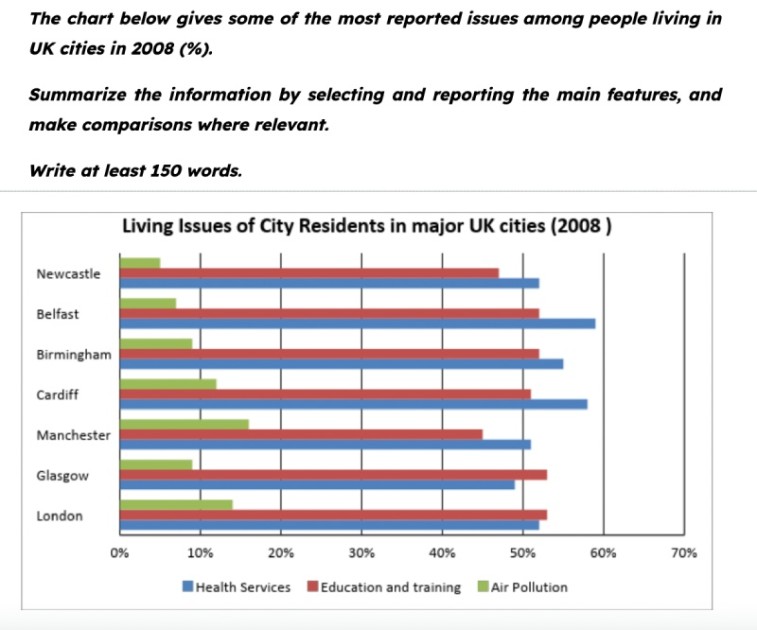
Đề mẫu để xây dựng cách viết dạng Bar Chart trong Writing Task 1 - Nguồn: Bestmytest
Thực hành phân tích đề:
Topic – Đối tượng của biểu đồ là gì: Living Issues of City Residents - dựa trên ba đối tượng là Health Services, Education and training, Air Pollution
Place – số liệu trong biểu đồ được lấy ở đâu: In major UK cities
Time – số liệu trong biểu đồ được lấy ở thời điểm nào: In 2008
Unit of measurement - Đơn vị đo của số liệu trong biểu đồ: Đơn vị đo lường: phần trăm
Bước 2: Note lại những thông tin quan trọng
Sau khi đã phân tích đề và nắm được những điểm mấu chốt, giờ là lúc bạn ghi lại thông tin quan trọng từ biểu đồ, bao gồm:
Điểm cao nhất? - Health Services
Điểm thấp nhất? - Air Pollution
Có sự thay đổi vượt trội nào trong biểu đồ?
Các điểm chung của số liệu?
Đây đều là những thông tin mà bạn có thể dựa vào để phân tích và so sánh theo đúng yêu cầu của đề bài. Nắm rõ các thông tin này giúp bạn hạn chế tình trạng liệt kê khi làm bài thi Writing Task 1.
Đăng Ký Thi IELTS Trên Máy Tính Ngay
Bước 3: Chiến lược viết từng phần của bài mô tả Bar chart
Cách viết phần introduction.
Trong phần giới thiệu, bạn chỉ nên diễn giải lại đề bài bằng cách thay đổi cấu trúc và sử dụng từ đồng nghĩa.
Cấu trúc viết câu mở bài: The bar chart + show(s)/illustrate(s)/give(s) information about + 3W (what?, where?, when?)
Ex: The bar graph compares the living issues of local people in some major cities in the UK during 2008.
Từ vựng thường dùng: Show - illustrate - give - compare,...
Cách viết phần Overview Task 1 dạng Bar chart
Ở phần tiếp theo này, bạn nên thể hiện các đặc trưng chủ yếu mà bạn có thể thấy trong biểu đồ, chỉ cung cấp các thông tin chung chung và so sánh nếu có.
Một vài lưu ý khi viết overview:
Overview nên gồm 2 câu, một là giới thiệu chung về biểu đồ và hai là những thông tin chính.
Không đưa số liệu vào overview.
Chỉ nên chọn 2-3 ý chính để viết.
Những cụm từ vựng IELTS Writing Task 1 Bar chart dùng cho phần Overview:
As is observed: Theo quan sát
Overall: Nhìn chung
Generally speaking: Nói chung là
At a first glance: Thoạt nhìn
As can be seen: Như có thể thấy
Increase/Rise: tăng lên, Decrease/Fall: Giảm đi, …
Remain stable: Không thay đổi
Hit the peak/ hit the highest point: Đạt điểm cao nhất
Slightly: Không đáng kể
Dramatically: Đáng kể
Gradually: Dần dần
Ex: As is observed, health services were the primary issue in most cities, followed by education and training. While air pollution remained a minor problem.
Tầm quan trọng của câu overview trong IELTS Writing Academic Task 1
Tổng hợp bộ từ vựng IELTS Writing Task 1
Cách viết phần Body
Phần Body là nơi bạn được phép trình bày nhiều thông tin chi tiết liên quan đến các dữ liệu bạn có. Ở phần này, chú ý thêm các câu so sánh vào bài viết, đừng chỉ liệt kê thông tin bởi điều này sẽ khiến bạn mất điểm.
Cụ thể, phần body sẽ có cấu trúc như sau:
Phần body 1: 3-4 câu miêu tả chi tiết nhóm thông tin đầu tiên từ biểu đồ/ điểm giống nhau của biểu đồ

Ví dụ cách triển khai body 1
Phần body 2: 3-4 câu miêu tả chi tiết nhóm thông tin tiếp theo/ điểm khác nhau của biểu đồ

Ví dụ cách triển khai body 2
Những cụm từ dùng trong phần body: accounted for: chiếm, reached a peak of: đạt cực đại là, just over: cao hơn 1 chút, approximately: khoảng, xấp xỉ, …
Cấu trúc sử dụng trong phần body: Fell to + số liệu, Fell by + phần trăm,…
Đăng Ký Thi IELTS Trên Giấy Ngay
Từ vựng dùng trong dạng bài Bar Chart
Mặc dù dạng bài Bar Chart được chia thành hai loại: loại có biến đổi theo thời gian và loại không có thay đổi theo thời gian, các thí sinh đều phải đưa ra các phân tích về đặc điểm, số liệu hay dự đoán những xu hướng dựa trên các thông tin của đề bài.
1. Từ vựng miêu tả câu mở đầu
2. từ vựng miêu tả sự thay đổi , 3. từ vựng miêu tả tốc độ thay đổi .
Gas prices have slightly increased in the last few months.
In the given period, the city's water consumption witnessed a moderate fall of approximately 15% from 180 to 153 million liters per day.
4. Từ vựng dùng để liệt kê
According to the graph/ First of all/ to begin with/ to start with/ Firstly: đầu tiên là
Secondly: thứ hai là
In turn/ before that/ subsequently/ following that: sau đó thì
Finally: cuối cùng là
Correspondingly: Tương ứng
Respectively: Tương ứng
5. Giới từ thường được sử dụng
In 1992, the Service Industry accounted for 4 percent of GDP, whereas IT exceeded this, at just over 6 per cent.
From 2000 to 2020, the number of households using solar energy as their primary source of electricity increased significantly, rising from just 500 to over 10,000.
6. Từ vựng chỉ số phần trăm - Các loại %, số phần và con số
tripled (v): gấp ba
doubled (v): gấp đôi
one-fourth: 1/4
three-quarters: 3/4
half: một nửa
double fold: gấp đôi
5 times higher: cao hơn gấp 5 lần
3 times lower: thấp hơn 3 lần
7. Từ vựng chỉ ngày tháng năm
From + năm: từ năm X
Between + Year X and Year Y: giữa năm X và năm Y
After + Year X: sau năm X
By/in + Year X: vào năm X
In + tháng X: vào tháng X
Cấu trúc câu dùng trong dạng bài Bar Chart
Cấu trúc trong đoạn overview.
Overview là đoạn cần tập trung vào những xu hướng tổng quát hoặc những đặc điểm nổi bật của cả biểu đồ. Bạn có thể áp dụng những trạng từ sau cho đoạn Overview của mình:
In general: nhìn chung thì
In common / Generally speaking / Overall
It is obvious: rõ ràng là
As is observed: theo quan sát
As a general trend: xu hướng chung là
As can be seen: có thể thấy là
As an overall trend: xu hướng chung là
As is presented: như đã thấy
It can be clearly seen that: có thể rõ ràng thấy được là
At the first glance, it is clear that .. : nhìn sơ có thể thấy ..
At the onset, it is clear that .. : rõ ràng là ..
A glance at the graphs reveals that .. : nhìn sơ biểu đồ cho thấy là..
Bài mẫu xây dựng cách viết dạng Bar chart trong Writing Task 1
Sau khi đã tham khảo những hướng dẫn viết Writing Task 1 dạng Bar chart bên trên, bạn hãy vận dụng để làm 3 đề mẫu dưới đây:
Bài 1: The graph gives information about the age of the population of Iceland between 1990 and 2020.
Summarize the information by selecting and reporting the main features, and make comparisons where relevant.

The bar chart compares the different ages of people living in Iceland between 1990 and 2020.
All in all, the size of the 25-54 age group increased the most over the period while the size of the two younger age groups decreased a little bit. The number of people in the two older age groups stayed about the same.
The 25-54 age group grew from approximately a third of the population in 1990 to nearly half of the population in 2020.
The older two age groups did not increase or decrease much. The size of the 65 and over age group remained at about 13%, whereas the size of the 55 -64 age group only fell from about 14% to about 10% of the population.
By contrast, the 0-14 age group fell from just over 25% in 1990 to just under 20% in 2020. Similarly, the 15-24 age group dropped from just over 20% of the population in 1990 to just under 10% of the population in 2020.
Bài 2: The chart and graph below give information about participants who have entered the Olympics since it began.
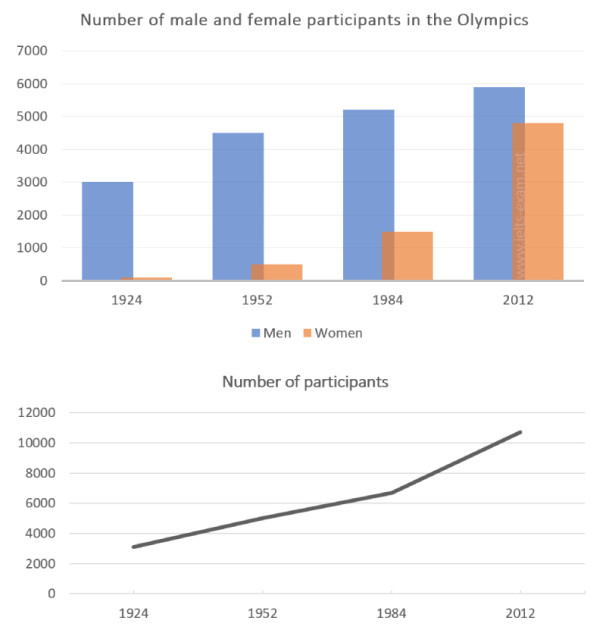
The two charts give information about the gender and number of athletes who have entered the Games since they started. The bar chart illustrates the number of men and women entering the Games, whereas the line graph shows the number of participants.
It is evident from the bar chart that, until 2012, there were always significantly more men entering the Games than women. In 1924 and 1952, there were hardly any women entering the Games, yet in 1952 there were over 4,000 male participants. In 2012, however, the number of female athletes rose significantly to nearly 5,000, only approximately 1,000 lower than male participants.
The line graph shows a similar trend, with the number of participants increasing throughout the century. The most significant increase occurred between 1984 and 2012 when the number of athletes rose from just over 6,000 to over 10,000 in 2012.
To summarize, therefore, since 1924 the number of athletes entering the Olympic Games has increased dramatically. This is particularly the case for women, who are now represented in nearly the same numbers as male participants.
Bài 3: The graph below shows the percentage of part-time workers in each country of the United Kingdom in 1980 and 2010.
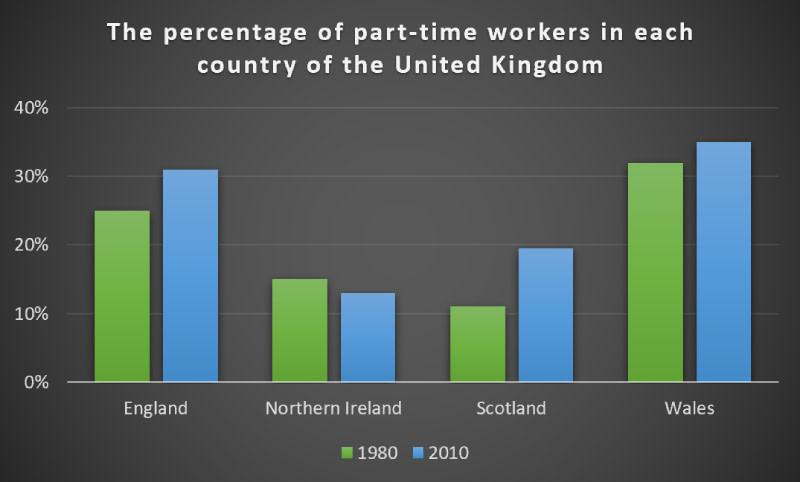
The given bar graph shows the rate of part-time employees in four different parts of the UK from 1980 to 2010.
Overall, except for the workers of Northern Ireland, all the people of other countries have shown a rise in the rate of their work as time continues. Also, Wales and England have the most active part-time workers in both eras.
The graph clearly depicts that in 1980, nearly 25% of people worked in England as part-time workers but manpower in whales is about 8% higher than that in England. After 30 years, England shows a greater rise in the rate of workers than that in Whales. But the overall percentage of employees in 2010 still seems to be higher in Wales.
Furthermore, Scotland has the lowest rate of part-time workers with just about 11% while Northern Ireland exceeds more than that in the starting year. As time passes by, the percentage of workers decreases in Northern Ireland in contrast increases twice as that in 1980 in Scotland.
Nguồn: IELTS Writing
>>> Bài viết cùng chủ đề:
Các dạng biểu đồ trong IELTS: Tổng quan & cách viết
Bật mí chi tiết cách viết dạng Map trong Writing Task 1
Trên đây là hướng dẫn cách viết dạng Bar chart trong Writing Task 1 kèm bài mẫu chi tiết. Hy vọng các thông tin trong bài đã giúp bạn đọc củng cố kiến thức và chuẩn bị tốt hơn cho kỳ thi IELTS sắp tới.
Tự tin ghi điểm dạng bài Bar Chart trong IELTS Writing!
Với các từ vựng và cấu trúc câu đa dạng liên quan đến dạng bài Bar Chart trong phần thi IELTS Writing Task 1 ở trên, hy vọng bạn đã nắm được phần nào cấu trúc bài thi và ghi điểm thật cao trong bài làm của mình. Bạn có thể đọc thêm chiến thuật giải quyết các dạng bài ở kho tài nguyên IELTS sẵn có của IDP để chuẩn bị tham gia thi IELTS trên giấy hay trên máy tính.
Và khi bạn đã sẵn sàng, hãy đăng ký thi IELTS với IDP ngay hôm nay !
Chia sẻ bài viết
Lộ trình học IELTS từ 0 đến 7.5 phù hợp với mọi trình độ
Lộ trình học IELTS từ 0 đến 7.0 chỉ trong 70 ngày
Lộ trình học IELTS từ 0 đến 4.0 cho người mới bắt đầu
Lộ trình học IELTS từ 0 đến 3.0 cho người mới bắt đầu hiệu quả
Các cách rút gọn mệnh đề quan hệ trong Tiếng Anh
Đăng ký thi thử IELTS miễn phí tại IDP
Nên thi IELTS trên giấy hay máy tính? Những thông tin bạn không nên bỏ qua
Làm quen với hình thức thi IELTS trên máy tính
Thi IELTS trên máy tính: Tìm hiểu ưu điểm, các dạng câu hỏi và câu trả lời cho kỳ thi IELTS trên máy tính
Đảo ngữ là gì? Các cấu trúc đảo ngữ trong Tiếng Anh
- Hình thức thi IELTS
- Các tổ chức công nhận IELTS
- Tin tức và bài viết cập nhật
- Sự kiện IELTS
- Hình thức thi nào phù hợp với tôi?
- Chương trình ưu đãi IELTS
- Đối tác IDP IELTS tại Việt Nam
- Câu chuyện thành công
- IELTS - Tấm vé vàng để đi du học
- Liên hệ IDP IELTS
- Thi IELTS trên máy tính
- Thi IELTS trên giấy
- IELTS Học thuật
- IELTS Tổng quát
- IELTS UKVI Học thuật
- IELTS UKVI Tổng quát
- IELTS UKVI Life Skills
- IELTS One Skill Retake
- Đăng ký thi IELTS
- Lịch thi IELTS
- Lệ phí thi IELTS
- Tìm địa điểm thi IELTS
- Câu hỏi thường gặp về IELTS
- Bài kiểm tra IELTS Familiarisation
- Ứng dụng IELTS by IDP
- IELTS Masterclass
- Tải các mẫu đơn
- Cam-pu-chia
- Cộng hòa Síp
- Netherlands
- New Caledonia
- New Zealand
- Papua New Guinea
- Philippines
- Ả Rập Xê Út
- Quần đảo Solomon
- Tây Ban Nha
- Quần đảo Ellice
- Các Tiểu Vương quốc Ả Rập Thống nhất
- Liên hệ với chúng tôi
- Thông báo pháp lý
- Chính sách quyền riêng tư
- Chính sách cookie
- Bản quyền 2024 IDP IELTS
- Skip to primary navigation
- Skip to main content
- Skip to primary sidebar
IELTS Training with Jonathan
Helping Busy People Succeed in IELTS.
How to describe Bar Charts in IELTS Task 1 Writing
By ielts-jonathan.com on 18 June 2022 0
Learning to write about IELTS Bar Charts
Before learning how to describe bar charts in IELTS Task 1, it would be useful for you to study these articles first.
If you are familiar with the content, you can continue to the next section.
IELTS TASK 1 Describing changes and trends
IELTS TASK 1 Working correctly with numbers
IELTS TASK 1 Increase your band score with Adjectives/Adverbs
IELTS TASK 1 Using Compare and Contrast language
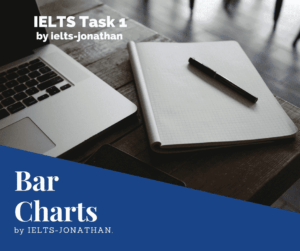
Bar charts usually have two main features that you need to notice – the comparison of two or more units or numbers in the same year, or charts that show changes over a period of time

For this type of essay it is standard to write a four paragraph essay, namely An Introduction, An Overview and Two Bodies
Have a look at these articles if you are unsure about the paragraphs of an IELTS report.
How to write an Introduction
How to write an Overview
How to write the Main Bodies
Writing about Bar Charts
Share Pin 491 Share Tweet 491 Shares
Bar charts are common questions in IELTS.
This format of question is very visual and can seem easy to answer.
This is often a mistake.
It is really important to be prepared for all types of IELTS questions. But, the good news is that the preparation won’t take as long as you might think.
There are different types of Bar Chart. All will require you to notice differences and trends.
In many ways the question is a similar task to Line Graphs except the information is presented in a different way.
Values may be presented as measurements, costs or numbers against units of time, cities, countries, months or types of people among others. A bar chart typically represents a period in the past.
It’s important to use specific vocabulary related to this task and the grammar needed here would be prepositions and the past tense to describe trends.
You would also need to use specific language that shows numbers and amount as well as the language required for Line Graphs.
Bar Chart Questions follow the same format as any IELTS Task 1:
- Introduce the map
- Give an overview of the main point/s (necessary for Band 6 and above)
- And provide the detail
This post will explain:
- The two types of Bar Chart question
- The tried and tested method for answering any map question
- How to write the introduction
- How to write about the detail showing trends and time.
- How to finish with a great overview
- The common mistakes IELTS students make
What is an IELTS bar Chart Question?
These questions can be divided into two types: past and present charts and show trends in one direction over time.
Official IELTS practice questions have featured information related to education, population, climate, exchange or school for example. In fact anything where the highest and lowest can be compared.
More good news is that the same skills and principles can be applied to any bar chart, whether in the past or present.
Let’s consider a typical question first.
The chart below shows the number of men and women in further education in Britain in three periods and whether they were studying full-time or part-time.
Summarise the information by selecting and reporting the main features, and make comparisons where relevant.
Write at least 150 words
A Good Teacher’s Guide to IELTS Planning.
Any good teacher will tell you that to be effective in Task 1 you need to understand the task quickly and plan an answer quickly too. You can do this like so:
Get an overall visual understanding of the map.
- Paraphrase the question
- Consider an overview
- Divide the process into past and present
- Include time to proofread your writing
Gaining an overall understanding of the Bar Chart
A bar chart has a number of features that require vocabulary related to time or number. So, you should start at the beginning, and look for and compare the obvious differences or trends.
In the example above, this differences are fairly obvious. Noticeable features are there were increases in enrollment for both men and women in full-time education and while there were increases in enrollment for women in part-time education this was not the same for men.
However, bar charts are not always as clear as this, and you may need to look more carefully to notice changes.
It’s quite a challenge to write about something you have never seen, so it is important that you look at other sample bar charts to get a good understanding of how they might vary.
Don’t worry , it doesn’t need to be perfect, you only have 15 minutes and just need to notice the main features and report them in an accurate way.
- Identify the obvious trend/s
- Is the trend increasing, decreasing or is it stable?
- Is the an exception to general trend ?
- Is it past situation or present?
- Units are often about time, are they days, months, years or decades?
- If they are not about time, what are they?
- If there is a key, what information is provided on the bar chart?
By answering these questions you will have already started planning your essay
Good News – Remember the IELTS task is not there to trick you, and you won’t be given a complicated process to describe. Your task is to report effectively and accurately.

As with any Task 1, you can begin by paraphrasing sentence (1)
This is the rubric or instructions.
Paraphrasing is a task that is worth learning to do well, and a good knowledge of paraphrasing will also help you in the Reading, Listening and Speaking part of the test.
Simply put, paraphrasing for IELTS means using different words and/or word order so the original meaning remains the same.
In order to remain the same, different words need to be synonyms, so man, male and person have a similar meaning, they are synonymous, but man, male, person and girl are not all synonymous.
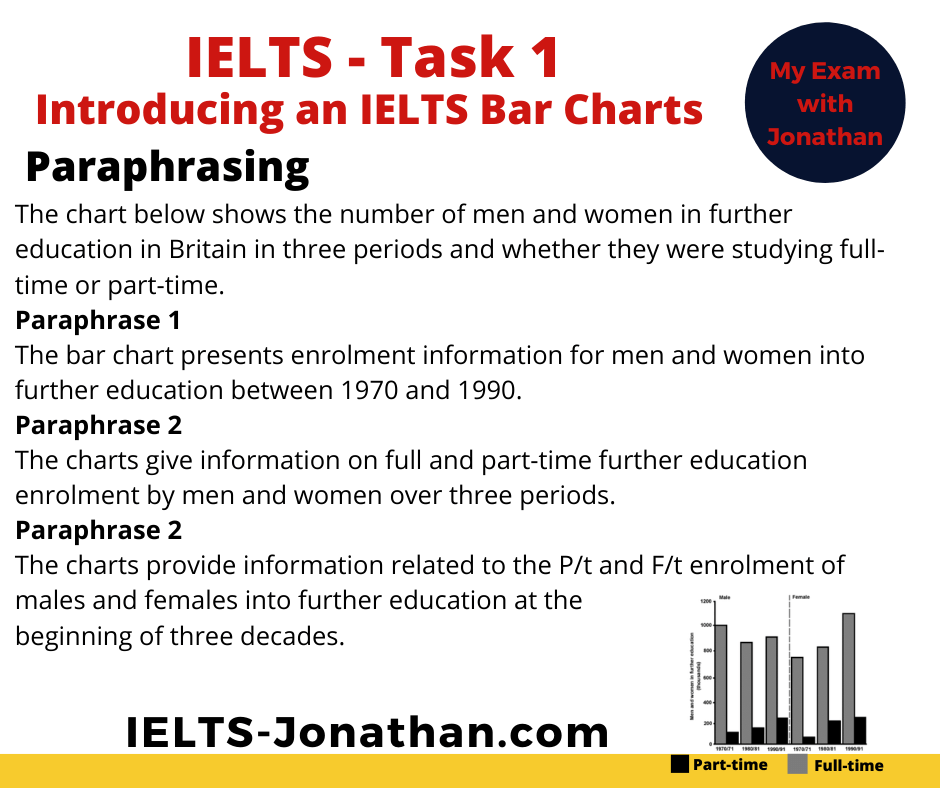
As you can see, all the information in the three sentences has been taken from the question, but it has not been copied.
If you do copy directly then those words are not used towards the word count and you will fail on TASK ACHIEVEMENT.
You need to write it in your own words.
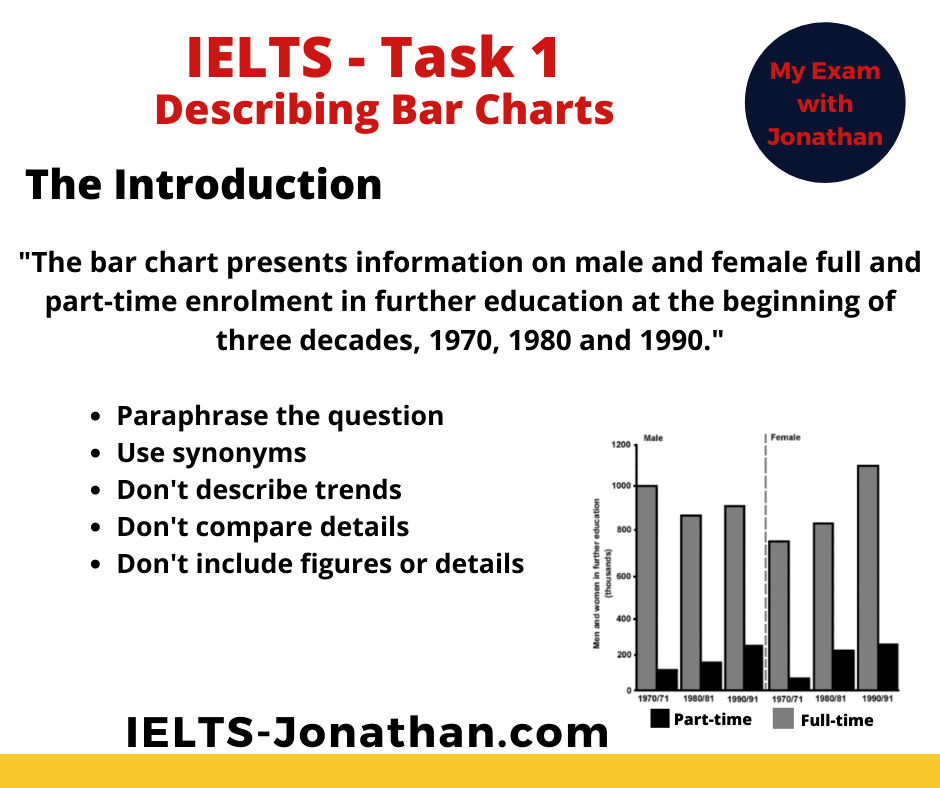
In any Academic Task 1 question you can rewrite (paraphrase) the questions and this will be the first paragraph. Excellent!
You can then move on further and consider the next section, the Overview.
Overview of the Bar Chart
The ‘ public band descriptors ’ state that to achieve a Band 6 or above for ‘ task response ’ the student must provide an overview in a Task 1. Without one, you are less likely to get a high score.
If you started planning at the beginning then writing a good overview will be a lot easier near the end.
Remember, the questions I asked you to consider. These should be sufficient to provide the 2 sentences you need to construct the basic overview.
- Identify the obvious trend
- Is the trend increasing decreasing, stable?
- Is there an exception?
- How are units measured?
An IELTS bar chart is different to a chart or table as there aren’t usually any key differences to identify.
So, as there are no differences to comment on, you should mention, for example, the obvious trend/s AND exception if there is one.
Providing the Detail
Now that you have completed paraphrasing the question and given the overview, the next stage is to explain the IELTS bar chart in detail.
You can do this by:
- Stating the significant trends
- Use verbs and nouns to show an increase, decrease or exception.
- Use prepositions to describe time and trend
Before you do this you need to consider the most suitable language that reflects the sophistication of the task.
In order to describe the process well there are three key aspects of language to be considered. These are vocabulary, prepositions and choice of grammar.
- Key vocabulary for describing Bar Charts
Numbers and Amounts

Vocabulary to describe time
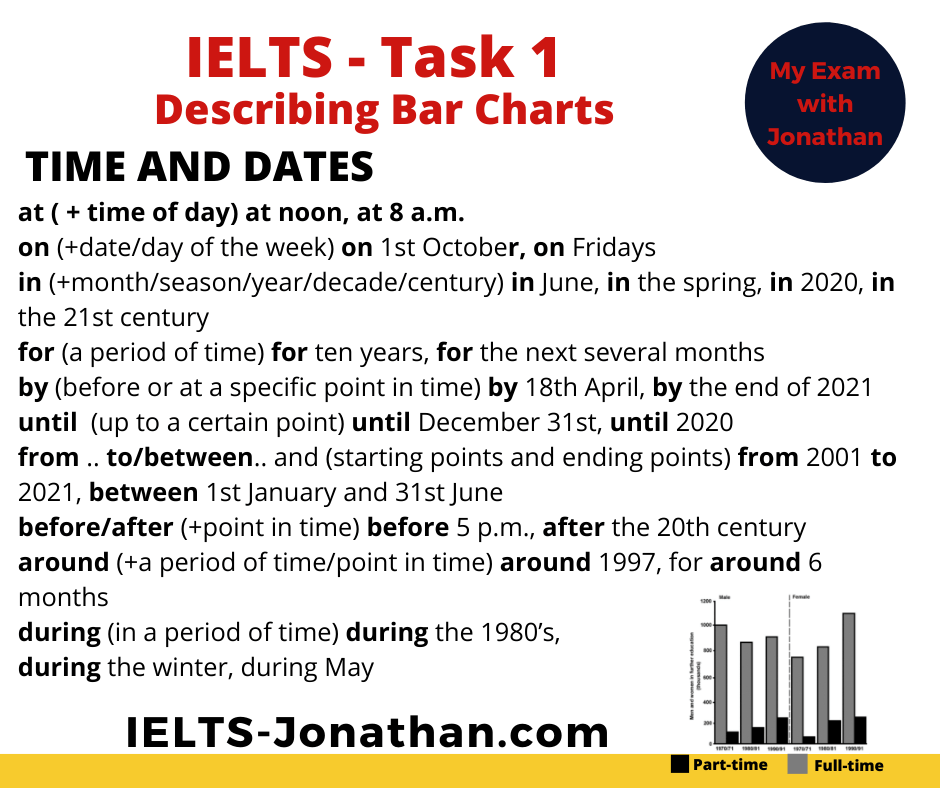
Vocabulary to describe changes over time
Trends that go up
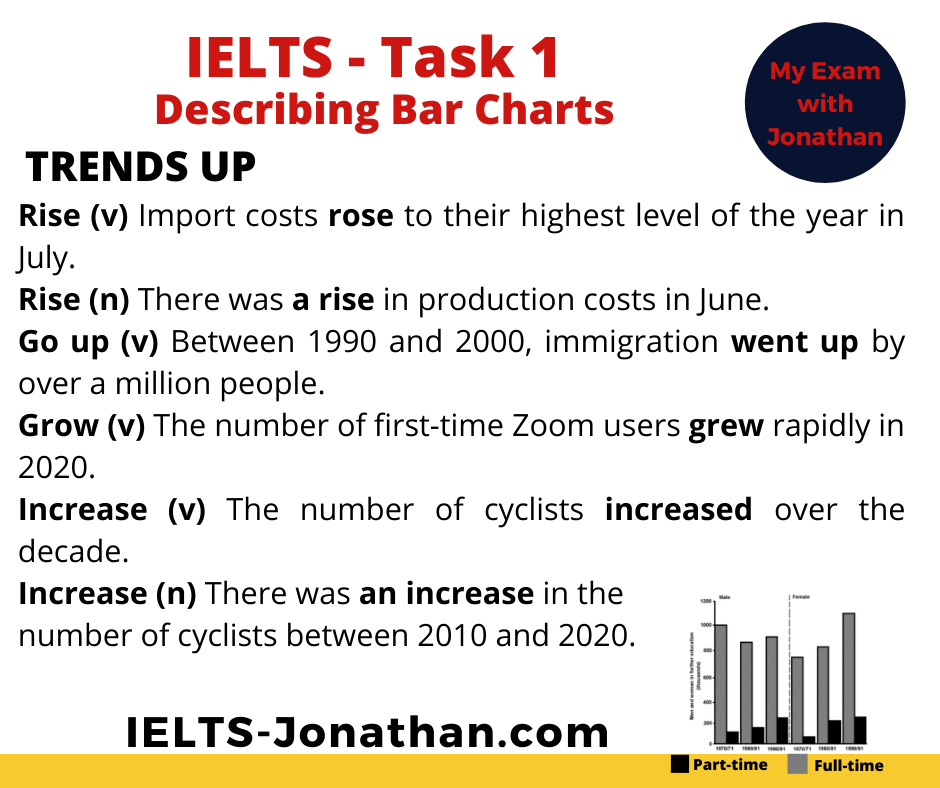
Trends that go down
Language to describe no changes
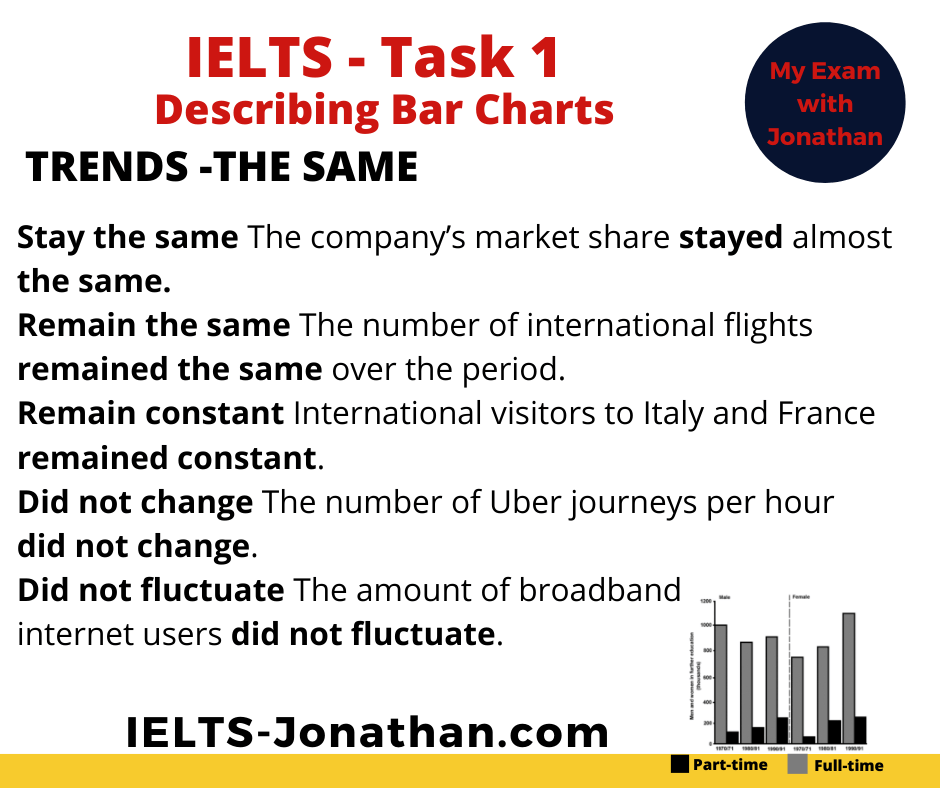
Language to describe multiple changes
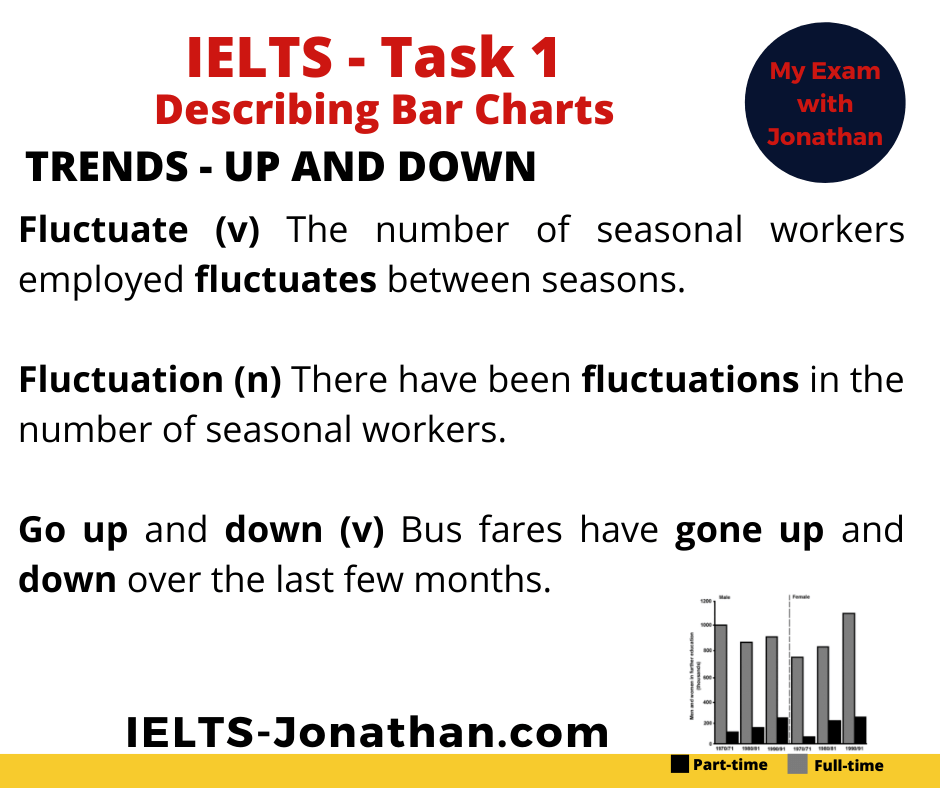
2) Structure for describing trends over time The Overview
When we describe change, the present perfect and the present perfect passive is often used. Also time phrases are used such as: over the 20 year period, from 1990 to 2000, over the years, in the last 10 years, in the years after 1990 and so on.
The Overview
The overview comes just after the introduction and makes a general statement about the main differences between the bar chart. The overview is quite short, maybe about 2 or 3 sentences. Do not go into detail in the overview.
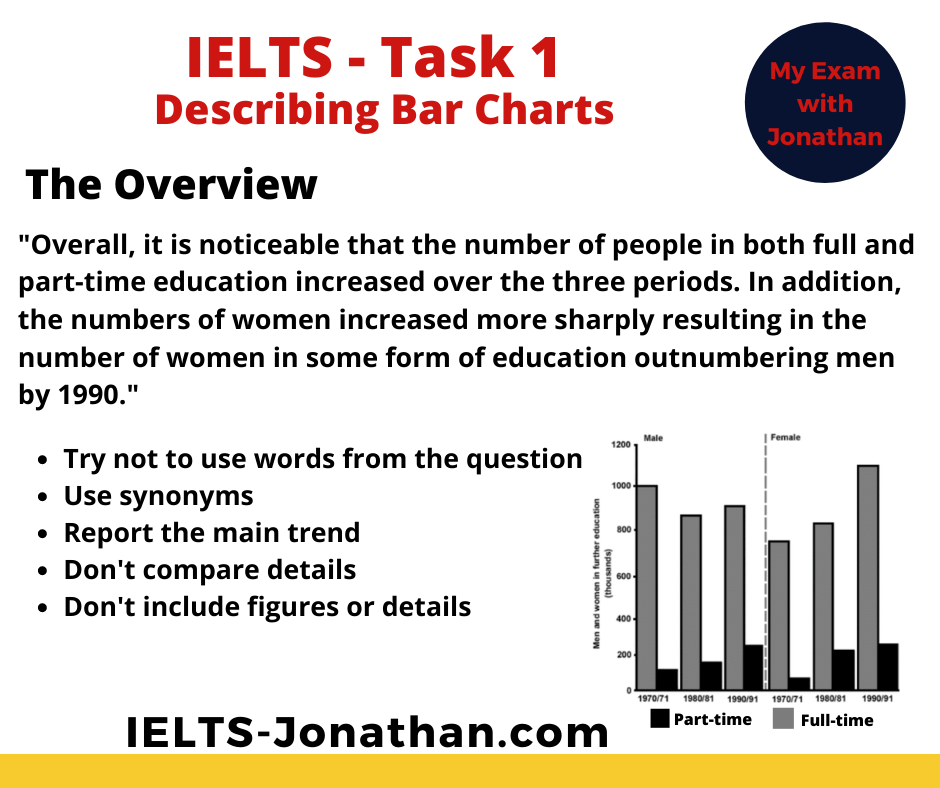
Now I can add the two Body Paragraphs using the language and vocabulary from above.
The Body Paragraphs
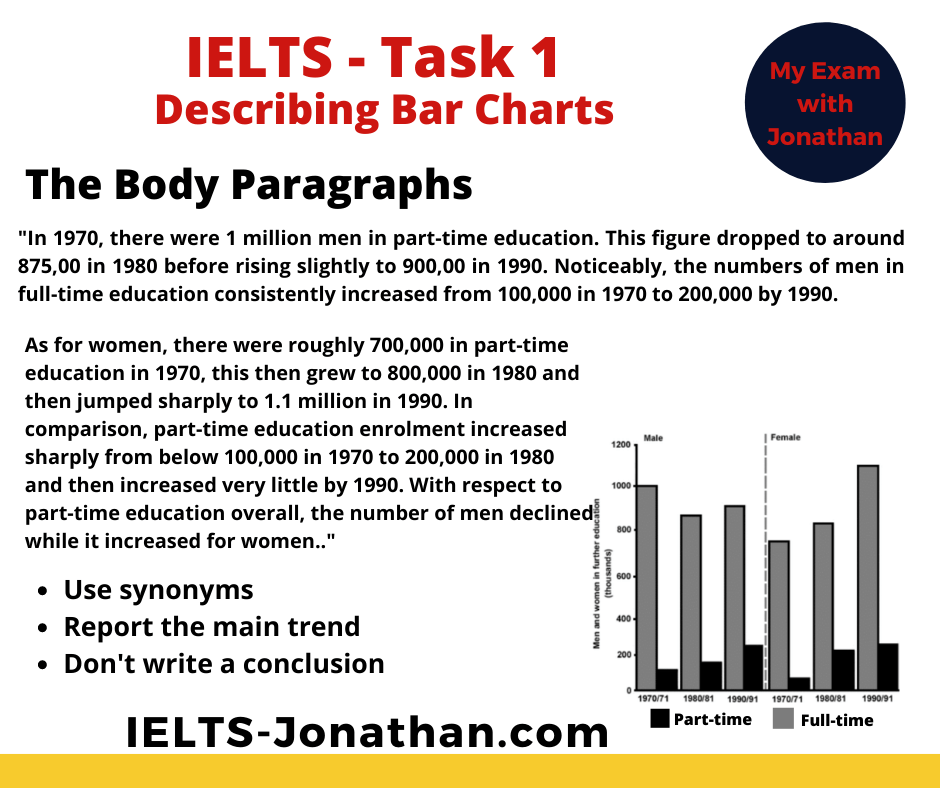
Varying your language for Task 1
One final tip for a higher score is variation in language.
It’s a good idea to avoid repetition when writing Task 1.
According to the information, the production of cars doubled .
According to the chart, twice as many cars were produced.
Sales increased to. Sales went up to.
The same can apply to nouns too,
For example, the number of cars produced , the total production of cars.
Common errors
A very basic error seen in Task 1 introduction is basic verb agreement.
Look at the two genuine examples below
The bar chart show The bar charts shows
In both examples it is unclear about the number of nouns discussed
Here is the correction:
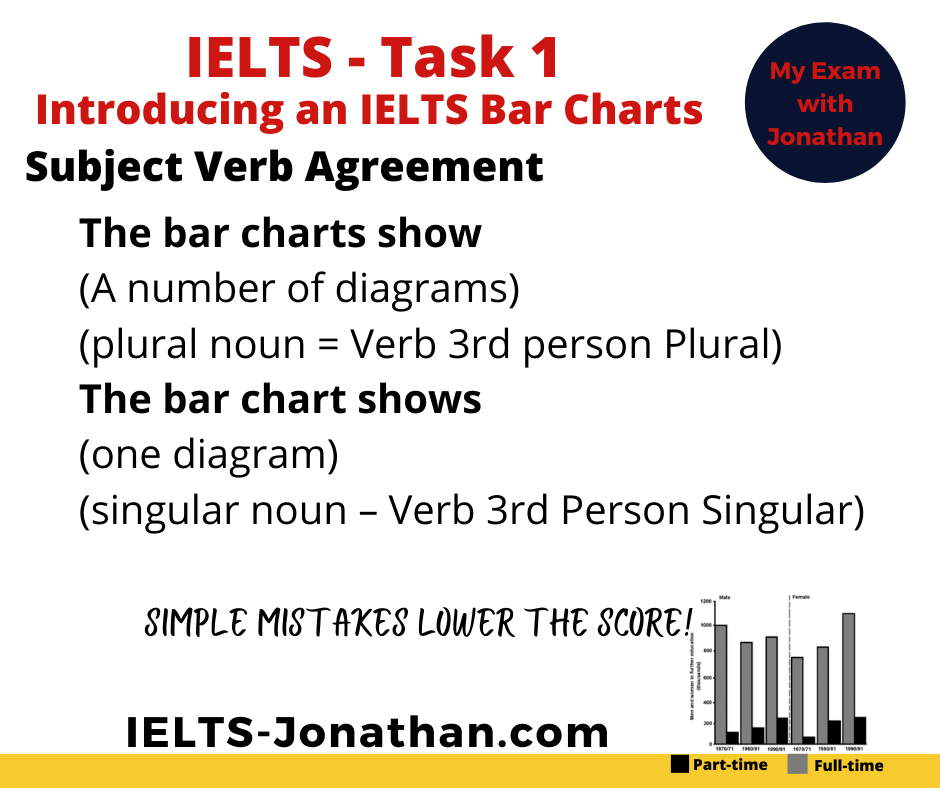
- Make sure you practise the passive so you know exactly how to use it.
Common errors using the Present Simple Passive
You will see from the description, it is more unusual to comment on who or what is doing the action so the ‘by….” phrase is often excluded.
- Singular or Plural
Notice these examples are incorrect.
There were an increase in rainfall. There was a declines in visitors. The number of sales gone up.
This is a really common mistake In Task 1 writing!
Here are the corrections:
There was an increase in rainfall. There was a decline in visitors. The number of sales has gone down.
Finally, check your Essay
Ideally, you need to allow 3 to 4 minutes at the end of the test to check and improve your writing. Often students don’t do this because they spend 2o minutes writing, but it is far better to write for about 15 minutes and allow 5 minutes to check and improve your writing.
From my experience the points you should check for are:
- Are there any obvious spelling or punctuation errors?
- Are the verbs the correct tense?
Additionally, you should consider these questions, but if you followed my planning advice you should be ok.
- Do the verbs agree with the subject?
- Does the description make sense? Does it follow the visual?
- Is there any repetition in vocabulary?
- Could this be improved with synonyms?
- Have I written over 150 words?
- Have I organised the text into at least 3 paragraphs?
- Have I noticed only the obvious features from the map?
- Have I included the prominent features in the overview?
- Have I NOT included my personal opinion?
Once you have done this, be proud of the final product!
Here’s my sample answer.
What do you think?
Sample Answer Adult Education Bar Chart
The bar chart presents information on male and female full and part-time enrolment in further education at the beginning of three decades, 1970, 1980 and 1990.
Overall, it is noticeable that the number of people in both full and part-time education increased over the three periods. In addition, the numbers of women increased more sharply resulting in the number of women in some form of education outnumbering men by 1990.
In 1970, there were 1 million men in part-time education. This figure dropped to around 875,00 in 1980 before rising slightly to 900,00 in 1990. Noticeably, the numbers of men in full-time education consistently increased from 100,000 in 1970 to 200,000 by 1990.
As for women, there were roughly 700,000 in part-time education in 1970, this then grew to 800,000 in 1980 and then jumped sharply to 1.1 million in 1990. In comparison, part-time education enrolment increased sharply from below 100,000 in 1970 to 200,000 in 1980 and then increased very little by 1990. With respect to part-time education overall, the number of men declined while it increased for women.
Word count (180)
Official Band Score Examples Task 1
If you’d like to see official examples of student’s work you can do so here .
All the Best, Jonathan
I’m Jonathan
I’ve taught IELTS and University English in more than a dozen universities and schools around the world.
I’m a parent, traveller and passionate about language teaching and helping students achieve their dreams.
Whilst living in Austria or working in Asia, I run IELTS courses to help students get to where they want to be.
If you are serious about IELTS, connect with me to see how I can help you.

Share this:
- Click to share on Twitter (Opens in new window)
- Click to share on Facebook (Opens in new window)
- Click to share on Pinterest (Opens in new window)
- Click to share on WhatsApp (Opens in new window)
- Click to share on Telegram (Opens in new window)
- Click to share on Tumblr (Opens in new window)
- Click to share on LinkedIn (Opens in new window)
- Click to print (Opens in new window)
Reader Interactions
Was this helpful leave a comment :) cancel reply, let me help you get the ielts result you need.
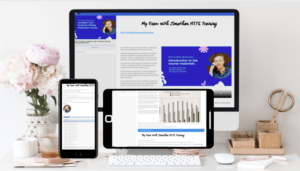
JUST WRITING FEEDBACK

Speaking Feedback
IELTS TRAINING
IELTS FEEDBACK
YOUR PRIVACY
TERMS AND CONDITIONS
Free IELTS lessons signup

- Academic practice
- General practice
- Task 1 Academic
- Task 1 General
- Task 2 (essay)
Answering IELTS writing task 1: bar chart
In this lesson we’re going to learn how to tackle bar charts in IELTS Writing task 1 questions to get the highest score. To get a band 9 in IELTS Writing task 1, you should follow this answer structure :
- Introduction
- General overview
- Specific features
Let’s look in detail how to apply this structure to an IELTS bar chart question .
IELTS bar chart Question :
The bar chart shows the divorce rates in two European countries from 2011 to 2015. Summarise the information by selecting and reporting the main features, and make comparisons where relevant.
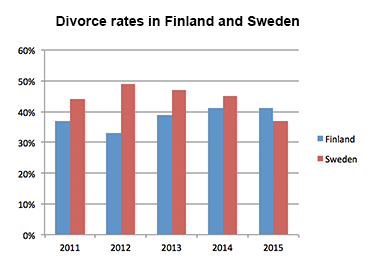
And now let's learn how to answer IELTS bar chart questions .
IELTS bar chart answering strategy :
1. Introduction
You should start your answer by writing an introduction . The introduction is 1 or 2 sentences, where you paraphrase the information from your question. You should mention two things in your introduction:
- what your graph shows
- for what period of time
In our example, the introduction can look like this:
The bar chart provides information about the percentages of divorces in Finland and Sweden between 2011 and 2015.
See how I used synonyms to paraphrase the question :
shows → provides information about divorce rates → percentages of divorces two European countries → Finland and Sweden (it’s good to be more specific) from 2011 to 2015 → between 2011 and 2015.
2. General Overview
The second paragraph of your answer is a general overview , where you briefly describe major trends on your graph. Ideally, you should describe 2-4 key features.
To make major trends easier to notice, you can outline Sweden’s bars and Finland’s bars like this:
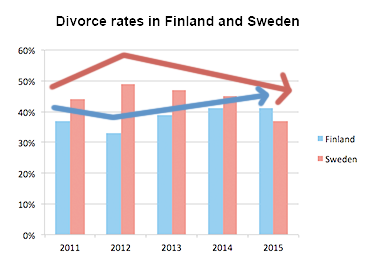
Now it’s obvious that:
- Sweden experienced a downward trend
- Finland experienced an upward trend
- both countries showed fluctuations
- Initially Finland had a lower rate, but in 2015 Finland outraced Sweden
Use word overall to start your general overview. In our case, the overview may look as follows:
Overall, Sweden experienced a downward trend, while Finland showed an upward trend throughout the period. Both countries’ divorce rates had some fluctuations. Although Finland initially had a lower rate, it outraced Sweden at the end of the period.
3. Specific details
After we’ve written the introduction and general overview, it’s time to give the specific details . You should describe the specific features in 2 or 3 (sometimes more) paragraphs.
You can group data in such way :
- Details about Sweden
- Details about Finland
When you have two countries (or two cities or any other two things depicted on the graph), the simplest way of grouping data - is to describe each country’s trend in a separate paragraph.
When giving specific features, you have to write exact numbers/percentages and include as much details as you can .
In our case, the specific details may look as follows:
Sweden’s divorce rate was about 45% in 2011, being higher than Finland’s rate by approximately 8%. Then, it rose to almost fifty percent in 2012. However, the figure showed a gradual decrease to about 47% in 2013, and continued to decline steadily to the end of the period, reaching around 45% in 2014 and hitting a low-point of about 37% in 2015. Percentage of divorces in Finland was less than 40% in 2011, and it decreased in 2012, when about one third of marriages in Finland ended with a divorce (as opposed to almost a half in Sweden). However, the figure experienced a steady growth during the next three years. It rose to approximately 30% in 2013, then increased by around 5% in 2014, and reached around 42% in 2015, outracing the rate of Sweden.
- When analyzing a bar-chart, we cannot always give exact details (due to inaccuracies of the chart), so use words around , about and approximately when giving inexact data.
- Give data for each year shown on the chart
The full answer + Practice
It’s the end, we have finally written the answer for IELTS bar chart question. And now, let’s practice: fill in the gaps in this answer with appropriate words .
The provides about the percentages of divorces in Finland and Sweden between 2011 and 2015.
, Sweden experienced a downward trend, while Finland showed an trend throughout the period. Both countries’ divorce rates had some fluctuations. Although Finland initially had a lower rate, it Sweden at the end of the period.
Sweden’s divorce rate was about 45% in 2011, being higher than Finland’s rate by approximately 8%. Then, it rose to fifty percent in 2012. However, the figure showed a gradual decrease to about 47% in 2013, and continued to decline steadily to the end of the period, reaching around 45% in 2014 and hitting a of about 37% in 2015.
Percentage of divorces in Finland was than 40% in 2011, and it decreased in 2012, when about one third of marriages in Finland ended with a divorce (as to almost a half in Sweden). However, the figure experienced a steady growth during the next three years. It rose to approximately 30% in 2013, then increased by around 5% in 2014, and reached around 42% in 2015, outracing the rate of Sweden.
(190 words)
- Practice Test
- Useful Tips – Tricks
- Full Writing Review
- General Writing Task
- Writing Task 1
- Writing Task 2
- Writing Exercises
- Writing Sample – Topics
- Writing Vocabulary
- Speaking Vocabulary
- Intro Question
- Speaking Part 1
- Speaking Part 2
- Speaking Part 2 – Audio
- Speaking Part 3
- IELTS Books
- Recent Exams
- IELTS Vocabulary
- Essay from Examiners
- IELTS Ideas
Two graphs give different information related to eight professional groups. The bar chart indicates the number of weekly work hours done by the groups while the pie graph illustrates the percentages of people suffering from stress related illness in the different professi ons given.
In general, business men work the longest among the eight groups while the smallest amount of time is normally worked by lecturers. According to the pie chart, lecturers struggle the most with work -related stress. Although their average working hours is smaller than any other group in the chart, lecturers suffer from the highest level of stress caused by their job.
The bar graph shows that business men and movie producers work the most at about 70 hours and 62 hours per week respectively. At the opposite end of the scale, lecturers work only around 25 hours. Working hours of other professionals varied with doctors, writers, programmers, lawyers and chefs working approximately 52, 46, 35 and 32 hours per week in the name ordered.
The pie graph shows that the professional who has the highest incidence of stress related illnesses is lecturers at 25%. Movie producers and doctors also have high rates with 18% and 15% each. The figures for business men, lawyers, chefs and writers can be grouped into percentages between 11 and 8%. The lowest rate of stress illness is attributed to programmers at only 5%, which is only a fifth the figure for lecturers.
(239 words)
- mixed chart
LATEST POSTS
Writing task 1: how recycled paper is made, writing task 1: the percentage of men and women aged 60-64 who were employed in four countries in 1970 and 2000, writing task 1: the average retirement age of males and females.

IELTS App - For Mobile
Ready for the IELTS exam with our IELTS app. Over 2 million downloads

Popular Last 24h
Ielts writing task 2: research, bar chart #55 – the percentage of young people in higher education in 2000, 2005 and 2010., ielts writing task 2 sample 20, writing task 2: many university students want to learn about different subjects in addition to their main subjects, cue card #53: talk about a newly built public facility (such as parks, cinemas etc) that improves/influence local life quality in your city, talk about your favorite sport (5 sample), topic: are parents best teachers.
- IELTS Test/Skills FAQs
- IELTS Scoring in Detail
- Forecast Speaking – 2023
- List IELTS Speaking Part 3
- List IELTS Speaking Part 1
- IELTS Writing 2023 – Actual Test
Our Telegram
Join our community for IELTS preparation and share and download materials.
The information on this site is for informational purposes only. IELTS is a registered trademark of the University of Cambridge ESOL, the British Council, and IDP Education Australia. This site and its owners are not affiliated, approved or endorsed by University of Cambridge ESOL, the British Council, or IDP Education Australia.
Latest Articles
Ielts speaking part 3: topic relax, describe a place | where you go to relax, ielts speaking part 1: advertisements (audio), describe a place where you like to go shopping , describe an event you attended, most popular, describe a film that made you laugh, describe a person whom you met for the first time and made you happy, topic: experience is the best teacher, describe something difficult you would like to succeed in doing, in many countries,today there are many highly qualified graduates without employment..
ieltspracticeonline All Rights Reserved

IELTS Writing Task 1: Single bar chart, writing strategies with model answer, vocabulary and bonus tips
This IELTS Writing Task 1 post focuses on strategies to write a good answer to a single bar chart. As you can see in this picture, there are very few data to cover an answer with 150 words. So, I’m going to show you the tricky ways to expand your answer here in an organized way. Try to follow the points discussed prior to the model answer. Also, take a look at the vocabulary and bonus tips. Please, consider them important and follow the steps because they will, without any doubt, guide you to cover a good band in Task 1.

First, we need to scan the title and the picture attentively.
The following bar chart shows the comparative selling rates of four types of books at the Ekushey Book Fair 2013. (RB’16, Sb’15)

How to write a good answer to a single bar chart:
As can be seen in the chart, it deals with the number of books sold in a book fair. Before we write the answer, we need to scan the picture well with the intention that no data goes unobserved. Every single feature will assist you to write the answer perfectly.
Ask yourself the following questions:
- What does your writing need to focus on here? Data details for each bar/ column? Or, any trends in sales of books?
Interestingly, there is no trend present here as this is not a column graph. Rather it has four bars showing the number of book sales that happened at the same time. So, it also focuses on public interest in books.
- Does your answer contain 150 words?
As it is a task requirement, you cannot write less than 150 words. If that happens, you will be seriously penalized. So, you need to check the number of words you wrote for this answer.
- Does your answer contain correct numeral information?
This means the representation of numbers in the Task 1 picture. It cannot mismatch with the answer. You will be seriously penalized for providing the wrong information. So, please be careful about the number you are writing.
- Does your answer have clear and solid paragraphing? It must have good paragraphing.
Please follow this link to get an idea of paragraphing for a pie chart/ bar chart.
https://ieltsdeal.com/2018/02/16/ielts-writing-task-1-how-to-write-single-pie-chart-with-strategies-model-answer-and-bonus-tips/
- Does your answer have any personal opinion, reasons or effects?
Do not include them. You will be penalized if you do so.
- Did you use the right language?
For answering this kind of picture, you have to write some sentences using a degree of comparison/ compare and contrast. To learn more about how to write sentences like this, please follow the link below.
https://ieltsdeal.com/2018/02/17/ielts-writing-task-1-task-2-grammar-for-comparing-and-contrasting/
Now let’s take a look at the model answer which I’ve prepared for you.
Model answer:
This bar chart is a clear illustration of the comparative selling rates of four kinds of books at the Ekushey Book Fair in the year 2013. In general, it is apparent that the maximum share of sales of book types went to novels while the minimum went to Poetry.
As it can be noticed in the chart, people bought approximately 4500 novels which comprised the highest figure in this chart. With a sale of around 500 books less than novels, science fiction took second place in the chart. About 2500 history books were also sold in the book fair and thus it gained the third position. Only around 500 poetry books were traded at this fair which was the lowest figure in the chart.
In fine, it is fairly apparent in the chart, people who visited the Ekushey Book Fair in 2013 showed their maximum interest in book types like novels and science fiction while they showed less interest in poetry.
(160 words)
Vocabulary:
Illustration = picture, diagram, image
Rate = number of selling units (for this chart)
In general = on the whole, overall, as a general trend,
Apparent = Noticeable, evident, visible, clear
Novel = work of fiction
Poetry = poems
History = the study of the past
Science fiction = a broad genre of fiction that often involves speculations based on current or future science or technology.
Figure = number, numeral
Comprise = consist of, include, contain
Highest = maximum
Gain = achieve, attain, get, earn
Traded = bought and sold
Lowest = minimum
Interest = attention, curiosity
Bonus tips:
Learn to paraphrase as quickly as possible. You cannot copy the title of the picture as it is. You must change the sentence formation and use synonyms. Copying the title will result in a penalty. So, rephrasing or paraphrasing the title will not only change the look of the introduction but also prize you with a good start and you will surely get a good band.
Leave a Reply Cancel reply
Your email address will not be published. Required fields are marked *

IELTS Writing Task 2: Agree disagree topic on using forensics to solve old cases; with 3 model answers
This IELTS Writing Task 2 post offers some sample answers to an agree-disagree topic. This agree-disagree topic asks the candidates to provide arguments as to whether new science related to criminal forensics should be used to look at old cases or not. In this post, you will find three great model answers which may help […]

IELTS Writing Task 2: an advantage-disadvantage essay on taking a gap year before starting university education; with plans and model answer
This IELTS Writing Task 2 post offers the insights of writing a great answer to an advantage-disadvantage essay. This task 2 question asks the candidates to provide their personal opinions on taking a gap year before starting university education. In this post, you will find a plan that can help you to write this answer […]
Welcome Guest!
- IELTS Listening
- IELTS Reading
- IELTS Writing
- IELTS Writing Task 1
- IELTS Writing Task 2
- IELTS Speaking
- IELTS Speaking Part 1
- IELTS Speaking Part 2
- IELTS Speaking Part 3
- IELTS Practice Tests
- IELTS Listening Practice Tests
- IELTS Reading Practice Tests
- IELTS Writing Practice Tests
- IELTS Speaking Practice Tests
- All Courses
- IELTS Online Classes
- OET Online Classes
- PTE Online Classes
- CELPIP Online Classes
- Free Live Classes
- Australia PR
- Germany Job Seeker Visa
- Austria Job Seeker Visa
- Sweden Job Seeker Visa
- Study Abroad
- Student Testimonials
- Our Trainers
- IELTS Webinar
- Immigration Webinar
A Magazine Wants to Include Contributions from its Readers – IELTS Writing Task 1
Updated On Apr 08, 2024

Share on Whatsapp
Share on Email
Share on Linkedin
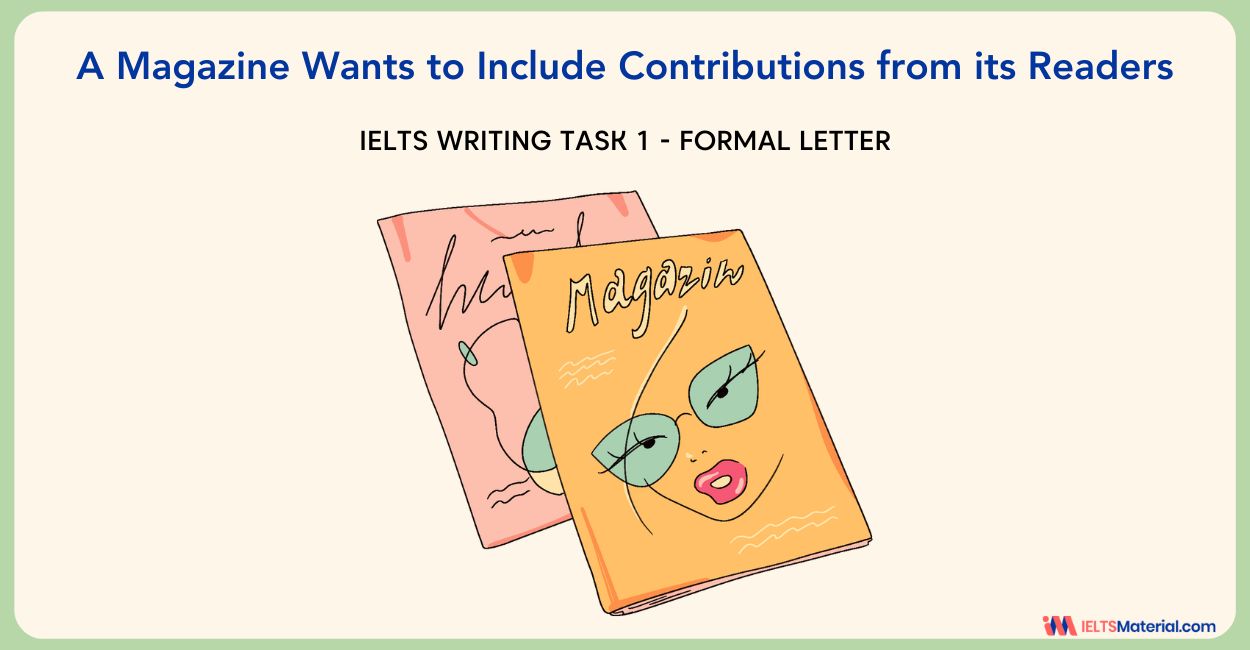
Limited-Time Offer : Access a FREE 10-Day IELTS Study Plan!
Table of Contents [ Show ]
- Question – A Magazine Wants to Include Contributions from its Readers
- Band 7 Sample Answer
- Band 8 Sample Answer
- Band 9 Sample Answer
IELTS letter topics such as requesting information, inquiring, or expressing gratitude typically based on practical and involve everyday occurrences are asked in the IELTS exam. Therefore, writing an appropriate response for letter topics like ‘A Magazine Wants to Include Contributions from its Readers’ is essential in IELTS General Writing Task 1.
Here, in this blog, we will discuss a formal letter topic – ‘A Magazine Wants to Include Contributions from its Readers.’ It will help you learn how to arrange your ideas rationally and adopt the right strategy for the letter. You can choose a topic from the IELTS Writing practice tests and structure your responses to help you improve your letter-writing skills for the IELTS exam.
Now, let’s explore the three sample answers, ranging from Band 7 to 9 on the IELTS General Writing Task 1 topic – ‘A Magazine Wants to Include Contributions from its Readers to enhance your letter-writing skills and boost your confidence for the test.
A magazine wants to include contributions from its readers for an article called ‘The book that influenced me most’. Write a letter to the editor of the magazine about the book that influenced you most. In your letter,
- describe what this book was about
- explain how this book influenced you
- say whether this book would be likely to influence other people
Band 7 Sample Answer for Writing Task 1 Question – A Magazine Wants to Include Contributions from its Readers
Dear Editor,
I am reaching out to share my profound appreciation for the book that has deeply impacted me: “To Kill a Mockingbird” by Harper Lee. This timeless masterpiece talks about the themes of racial injustice, moral development, and empathy in the 1930s in South America.
“To Kill a Mockingbird” has played an important role in broadening my perspective on prejudice and discrimination while nurturing within me a sense of empathy and righteousness. The character of Atticus Finch, with his unwavering dedication to honesty, has served as a role model to me and has motivated me to stand for justice and equality in my own life.
I strongly believe that “To Kill a Mockingbird” possesses the power to influence others in a similar manner. It is universal themes and moving narratives that resonate across diverse audiences, sparking self-reflection and nurturing empathy. Therefore, I wholeheartedly recommend it to anyone seeking a captivating and transformative literary journey.
Warm regards, Reynold Smith
(157 words)
Aspiring to crack IELTS General Writing in 1 go?
Sign up for a FREE demo now!
Band 8 Sample Answer for Writing Task 1 Question – A Magazine Wants to Include Contributions from its Readers
I am reaching out to share with you the profound impact a book has had on my life: “The Alchemist” by Paulo Coelho. This captivating narrative follows Santiago, a shepherd boy, on his journey to uncover his personal legend and realize his dreams.
“The Alchemist” has been a guiding light, teaching me invaluable lessons about pursuing my dreams, embracing uncertainty, and trusting in life’s journey. Santiago’s adventures have instilled in me the importance of persistence and chasing the call of my heart. This book has motivated me to take risks, pursue my passions, and never settle for a life lacking joy and fulfilment.
I am convinced that “The Alchemist” has the power to motivate countless people to chase their dreams with determination. Its timeless wisdom and deep messages can touch anyone, no matter where they come from. It’s a source of inspiration that can lift the spirits of many readers and guide them on their own journeys.
Best regards, Elizabeth Shines
(164 words)
Unlock 2 IELTS General Writing ebooks for the price of 1!
Band 9 Sample Answer for Writing Task 1 Question – A Magazine Wants to Include Contributions from its Readers
I am excited to share with you a book that has made a huge impact in my life recently: “The Catcher in the Rye” by J.D. Salinger. This classic book follows Holden Caulfield, a teenager dealing with growing up and society’s expectations.
I was able to resonate with my life with this book as it clearly captured the confusion and doubt of being a teenager. Holden’s search for truth in a world full of lies mirrored my own struggles that I came across as a teenager. Moreover, it made me think about what I stand for and who I want to be.
I firmly believe that “The Catcher in the Rye” possesses the ability to connect with readers across generations, as it deals with the universal themes of identity, isolation, and the search for the meaning of life. Its unfiltered portrayal of adolescence and emotional depth make it a timeless narrative capable of shaping and motivating individuals for years to come.
Warm regards, Rishab Patel
(169 words)
Now that you have gone through the sample answers on the topic – ‘A Magazine Wants to Include Contributions from its Readers – it is time for you to try writing some letters on your own to excel in this section in the IELTS exam. For that, leave your answers as a comment below or you can use our FREE evaluation service!
Additional Resources
- IELTS General Writing Task 1: Letter Writing Samples and Tips
- IELTS Letter Writing Topics 2024 | IELTSMaterial.com
- You recently bought a piece of equipment for your kitchen – formal letter
Practice IELTS Writing Task 1 based on report types

Start Preparing for IELTS: Get Your 10-Day Study Plan Today!
Nehasri Ravishenbagam
Nehasri Ravishenbagam, a Senior Content Marketing Specialist and a Certified IELTS Trainer of 3 years, crafts her writings in an engaging way with proper SEO practices. She specializes in creating a variety of content for IELTS, CELPIP, TOEFL, and certain immigration-related topics. As a student of literature, she enjoys freelancing for websites and magazines to balance her profession in marketing and her passion for creativity!
Post your Comments
Recent articles.
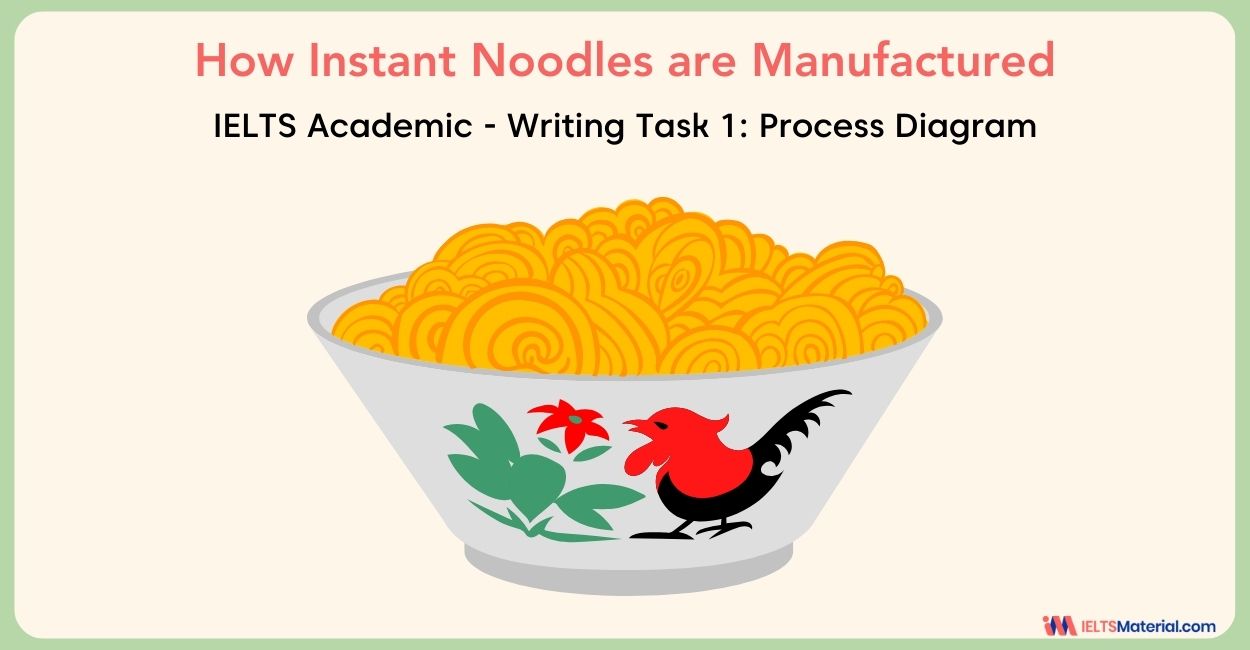
Kasturika Samanta
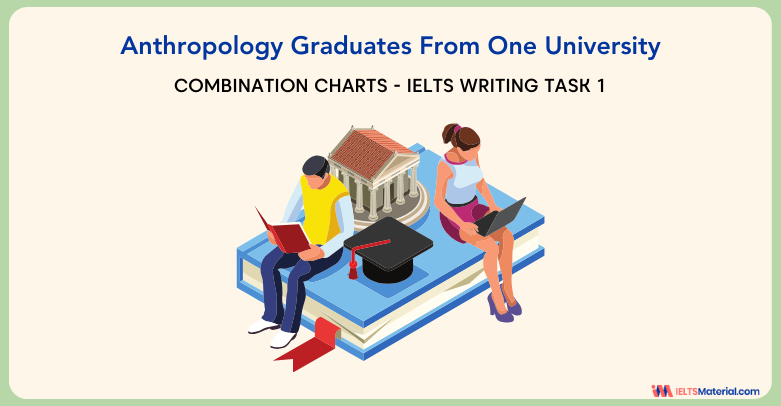
Raajdeep Saha
Our Offices
Gurgaon city scape, gurgaon bptp.
Step 1 of 3
Great going .
Get a free session from trainer
Have you taken test before?
Please select any option
Get free eBook to excel in test
Please enter Email ID
Get support from an Band 9 trainer
Please enter phone number
Already Registered?
Select a date
Please select a date
Select a time (IST Time Zone)
Please select a time
Mark Your Calendar: Free Session with Expert on
Which exam are you preparing?
Great Going!
IELTS Preparation with Liz: Free IELTS Tips and Lessons, 2024
- Test Information FAQ
- Band Scores
- IELTS Candidate Success Tips
- Computer IELTS: Pros & Cons
- How to Prepare
- Useful Links & Resources
- Recommended Books
- Writing Task 1
- Writing Task 2
- Speaking Part 1 Topics
- Speaking Part 2 Topics
- Speaking Part 3 Topics
- 100 Essay Questions
- On The Day Tips
- Top Results
- Advanced IELTS
How to write a line graph for IELTS writing task 1
Learn how to describe a line graph for IELTS writing task 1. IELTS Line graphs are common in writing task 1 along with bar charts, tables, maps, diagrams and pie charts. This lesson was last up-dated in 2018.
The guidelines below will help you structure your line graph answer and focus on the right aspects for a high score.
Steps: How to write IELTS Line Graphs
- try to include all information from the two axis and the names of categories.
- do not divide your key points into different paragraphs. Make sure you include the main increases and decreases shown.
- Use different verbs and nouns
- Use a range of adjectives and adverbs
- Vary your time phrases
- Click here to get a word list: LINE GRAPH VOCABULARY
- Don’t always give from … to … for the amounts, sometimes you can give the difference “it increased by double..”.
- Put numbers or percentages to support your sentences in the body paragraph. Failure to do that will result in a low score.
- Leave an empty line between paragraphs to make them easier to see. This is not a rule, it is a strong recommendation.
- If the line graph contains many lines and a lot of movement, be selective. You are being marked on your ability to select key features.
- Don’t spend more than 20 mins on task 1. You will need a full 40 mins for task 2.
- Write 150 words or more. Aim for about 160-190 words. Don’t write under the word count.
- Click here: IELTS Writing Task 1 Model Answers
Line Graph Sample
It is not common to be given only one line in IELTS writing task 1. However, this answer will provide you will an example of vocabulary, layout and general content.

- Source: IELTS Liz
Line Graph Model Answer
The graph illustrates how many people from the age of 65 and above were reported to have contracted influenza in a particular village in the UK from 1985 to 1995.
Overall, the number of cases of elderly people with influenza increased over the period given. The highest number of people with the illness can be seen in 1991.
In 1985, the number of cases of influenza stood at 40 and then rose steadily over the next three years to reach 55 in 1987. In the following year, 1988, the figure dipped slightly to below 50 after which it rose significantly to reach a high of 75 in 1991.
From 1991, there was a decrease to about 60 in 1993 of the number of reported cases of influenza. From this point, except for a slight increase of about 5 cases, the number remained at about 60 at the end of the period.
Focus Points:
Take time to read through the model and pay attention to:
- the content of each paragraph
- the use of verbs, nouns, adverbs and adjectives
- the logical order of information in the body paragraphs
Please note: this is a practice exercise lesson. It is rare for IELTS to give a one-line graph. So, use this to practice language and technique.
Recommended
- IELTS Writing Task 1: Tips & Model Answers
All the best
The line graph illustrates how many number of cases of elderly people over than 65 years, who infected by influenza in some UK village between 1985 to 1995.
Overall, the number of reported people with influenza had been increased over given time. The highest reaching point the influenza cases had been reported was in 1991 for about 75 cases.
is it okay to use [the number of ] more than 4 times
There is no rule that states how many times a certain word can be used. The marking system doesn’t work this way. For example, the word “people” is likely to be repeated a number of times in some IELTS writing task 2 essays and that is fine, even for a high score essay. As long as there is a range of language in your task 1 report and you have demonstrated the skill of paraphrasing, such as “the figure” or “how many”, you can repeat words within reason. IELTS Writing Task 1 is short, roughly between 7 and 9 sentences on average for a high band score report, and within those few sentences you need to show range of vocabulary. So, while there is no rule, I’m sure when you proof read your writing, you can see whether or not you have too much repetition.
Thanks a billion dear Liz.
You’re welcome 🙂
You are doing a wonderful job, Liz. May God always keep you healthy, happy, and prosperous. I have been teaching for the past 27 years and I still see that there are only a handful who are committed to teaching. You really are one of those. Kudos, Liz.
Thanks. That’s a really kind comment.
Thanks a million.💝💝💝
Hi, Liz. Please evaluate.
The graph illustrates the number of people aged 65 years and above with influenza in a particular village in UK between year 1985 to 1995.
Overview, the number of infected aged people with influenza increased over the years. In the year 1991,the highest number of people with the case were reported, whereas the lowest case was reported in 1985.
In 1985, the number of cases of influenza stood at 40 and then rose steadily to 55 in 1987. There was a slight fall in the number to 50 in the subsequent year afyer which it leveled off to hit a high of 75 in 1991.
Between 1991 to 1993, there was a drop from 75 to 60 in the number of people reported to be infected with influenza. The number remained constant at 60 from 1993 to the final year except for a slight increase of 5 cases reported in 1994.
Please Evaluate. The graph illustrates the number of people above the age of 65, who got infected by influenza flu in a particular village in the UK from 1985 to 1999. Overall, the number of cases of influenza increased over the time span, the least number of cases was 40 in the starting year while the maximum number was 75 in the year 1991. At the beginning of the period, the number of people infected with flu was 40, which increased to 55 in 1987 before dipping down to just below 50 in 1988. Afterwards the figure got a increment till it reached a high of 75 in the year 1991. After the year 1991, the cases of influenza saw a drop till they reached 60 in 1993 . From this point a slight increment (about 5 cases)was seen in the number in the year 1994 but in the last year figure dropped to 60.
Hi Liz thanks a bunch for your beneficial tips and answers. Honestly I’ve got a problem!! Is the “overview” of writing task 1 necessary? I mean we don’t have to use any numbers in it??? Cause i’m really confused. I live in Iran and I’ve taught to prepare my writing in just 3parts including: Introduction 2 or 3 body paragraph and Conclusion! Without overview. WHAT SHOULD I DO??
The overview is the most important paragraph for academic writing task 1. It contains a summary of the key features. This means you collect and describe all key features in that paragraph. The numbers and detail, you present in the body paragraphs. See my model answers and tips about the conclusion: https://ieltsliz.com/ielts-writing-task-1-lessons-and-tips/
Thank you Liz. It’s really effective.
Hello Liz, Thank you very much for the content that you produce. I’m using it as a main source for my IELTS preparation. I’m struggling a lot with identifying key features of a graph. Not sure why, but I usually end up writing too much information in an overview. Do you have any suggestions or tips on how to properly identify the key features for the overview? Thank you in advance.
Give a bird’s eye view – what goes up or down over the period. Then mention which might be higher or lower. Those are two key features that are in most line graphs. Another option is to add an unusual key feature – ie when lines show opposite trends (but this isn’t common). So, the two common key features I mentioned will be two sentences – one each. Your task is to simplify what you see – not complicate it.
thank you liz.Your lessons are too helpful.
Hi , Can you please let me know that is it ok to use brackets in your writing tasks ?
See my model answers for writing task 1 on this page to learn your answer: https://ieltsliz.com/ielts-writing-task-1-lessons-and-tips/
Hi liz, Somebody told me that, for graphs ‘Overall Statement’ should put at last, rather than within introduction or second paragraph. To what extent it is right??
There are no rules about this. The examiner will mark you based on logical organisation. Your overview statement can come before or after the smaller detail. This means it comes before or after the body paragraphs.
Mam, as you said before, I would prefer “overall” just after the Introduction paragraph. thank you so much for your worthful lessons! All of the classes are excellent and it means a lot…
Hello liz I couldnot find your answers for all the writing task 1 ,i had found it once,but now i could’nt find it again rather those in the home page..please help me this..that is really usefull for me.
Go to the red bar at the top of each page and click on the words: Writing Task 1. All main pages are accessed through the red bar.
Thank you so much for your valuable guidance. I request you to provide one more example on line graphs which has 3-5 lines so that it would be better to learn and write in the exam. I also want to inform you that I am planning to appear for my IELTS in the month of October and your website is the only source for me to study. So I request you to help me in this and i hope that it would be better for others also. Looking forward to get positive response from your side. Thanks again in the advance.
IT’s certainly something I will put on my list of things to do, but I’ll actually be taking a break in September and possibly October too. Only a few reading or listening lessons will be posted during that time as well as updated topics.
and plateau word good for line graph
If you don’t know it, don’t use it.
Hello Liz mam, I’ve a question. Can we use both verb+adverb and adjective+noun in a line graph or we have to choose only one pair for whole graph. Thanks in advance.. Abdul….
You should alternate so that you demonstrate your language skills.
Dear Liz, It is possible in Writing task 1 just have 1 body paragraph ?
If you want a good band score, then you need to demonstrate the skill of organising paragraphs. See the band score requirements.
Excuse me, Why ‘the origin number’? I think that should be ‘the original number’
Thanks for spotting it. It’s a typo. Liz
Dear madam,can we mention dates in overview paragraph.what I mean is that mentioning time phrases ” at the beginning of the period,during mid years,at the end of the period” while describing key changes would’nt be better instead of writing specific dates such as,1999,2000 or it does’nt affect much.
https://ieltsliz.com/ielts-liz-news/
hey Liz thnas for everthing
Hi Liz, Question about the intro, how come it is “over 10 years” when it is from 1983-1992? Thanks, Joharra
The word “over” does not mean “more than” in this context. It refers to over the period. There are 10 years given. Liz
Hi Liz, Just a follow up question. So the counting of years should start at the first given year, which is 1983? However, 1983 + 10 = 1993. In the line graph it is 1992. There was another essay says 26 years (1981-2007) which is correct when being added (1981 + 26 = 2007). Just really curious. Do you have any explanations about this? And one last question, should the overview be in a separate paragraph or part of the intro? Thanks a lot! Joharra
You can count it on the graph, not by doing calculations. Just look at the graph and count. Liz
Thanks! that makes everything clear 🙂
Hi Liz, thank you so much for you free lessons, thank you for teaching me that overview contains the key features or the highest or the lowest point ..but i am still struggling to understand the real content of overview, I would like to ask about your overview above, you wrote” Overall, the number of cases of disease X remained below 200 over the period given except for a considerable surge between 1989 and 1991 when the figures doubled.” -In 1991, the number of cases is actually 350 which is not double of 200, so, is it still fine or accurate to say that” the figure doubled”? or should we say ”…the figure almost doubled?because it is doubled in 1989 (400 cases) but not in 1991 (350 cases). or does the accuracy of information we give in overview is not 100% required?
My last question is about Grammar, would you please explain a bit more when we put ”s” in ”figures”? One student wrote ”’The figures rose steadily in the next four years, to reach its first peak in 1987” and you asked to take off ”s” in figure. when we should not put ”s” like”figure”?thank you.
The overview contains a description, so if we write “it doubled” as a description it is fine. But you can certainly make it clearer by writing “it more or less doubled”. As long as you don’t write “it doubled exactly”. But you need to understand that we are not referring to details. In the first years the numbers were 200 and under, then they reached 400. The description is “doubled”. If you get lost in details, then it isn’t an overview.
Usually, we write about “the figure” rather than using the plural. All the best Liz
Many thanks, God bless you!
I am from Mongolia. I am doing independent study on the preparation of IELTS examination. Thank you for helping the students like me around the world. I would like to kindly ask you to check my writing below in order to let me know my writing skill in task 1.
The line graph illustrates the amount of goods transported in four different ways (road, water, rail and pipeline) in Uk between 1974 and 2002. The units are measured in million tonnes.
Overall, over the period, the highest amount of goods was transported by road while the least amount of goods was transported by pipeline. Interestingly, all the amounts of goods were increased over the 28 years except the amount of rail transportation which almost reached back to it’s original number.
In terms of the road, the amount of goods was transported, it began about 70 million tonnes which rose steadily over the following 18 years to reach over 80 million tonnes in 1992. In the following 4 years, there was a gradual decline after which it grew up to nearly 100 million tones. Likewise, about 39 million tonnes of goods was transported through water in the first year and then the figure fluctuated slightly and rose to about 65 million tones. Similarly, in 1974, the figure of the pipeline transportation stood at about 5 million tonnes and there was a steep fluctuation until it leveled out from 1995 to 2002.
On the other hand, the amount of goods was transported by train was 40 million tonnes in 1974 which was followed by slight changes and reached at just above it’s beginning figure of 40 million tonnes.
Please read my notice: https://ieltsliz.com/posting-writing/ Thanks Liz
how to write bar graph
There is a free video and other lessons for bar charts on this page: https://ieltsliz.com/ielts-writing-task-1-lessons-and-tips/ Liz
Hello How can apply this sentence structure. Subject+ verb + proposition + indirect object + direct object. In graph and essay
You will find sentence structure lessons for line graphs on this page: https://ieltsliz.com/ielts-writing-task-1-lessons-and-tips/ Thanks Liz
Speak Your Mind Cancel reply
Notify me of new posts by email.
Advanced IELTS Lessons & E-books

Recent Lessons
Ielts model essay -two questions essay type, ielts bar chart of age groups 2024, ielts topic: urban planning, ielts listening transcripts: when and how to use them, 2024 ielts speaking part 1 topics, vocabulary for government topic.

Click Below to Learn:
- IELTS Test Information
Copyright Notice
Copyright © Elizabeth Ferguson, 2014 – 2024
All rights reserved.
Privacy Policy & Disclaimer
- Click here: Privacy Policy
- Click here: Disclaimer
Return to top of page
Copyright © 2024 · Prose on Genesis Framework · WordPress · Log in

IMAGES
VIDEO
COMMENTS
For task 1 of the IELTS writing test, you may be asked to write about a bar chart. You will have to write more than 150 words and it is recommended that you do this in 20 minutes or less. (You will have a total of 1 hour for 2 tasks.) It is important to note that you do not have to describe everything in the chart.
There are 5 steps to writing a good IELTS bar chart essay: 1) Analyse the question. 2) Identify the main features. 3) Write an introduction. 4) Write an overview. 5) Write the details paragraphs. Use this simple planning process as you practice writing IELTS bar chart essays and you'll have no problem remembering it in the exam.
IELTS Academic writing task 1 - Bar Graph. A bar graph (also known as the bar chart) is a graph that contains either horizontal or vertical bars to present data comparison or contrast among categories or variables. In your IELTS Academic task 1, you might get a bar graph that will have numerical values of different variables shown by the length and height of lines or rectangular shapes or ...
IELTS Bar Chart Tips Video Tutorial. This video lesson shows you how to tackle an IELTS bar chart for writing task 1 (academic paper). To see the full model answer for this video lesson, please click on the link above. Also read the summary of tips below the video.
An IELTS writing bar chart, also known as a bar graph, is something you may encounter in writing task 1 of the IELTS academic exam. The writing section of the test lasts for 60 minutes in total, and you should dedicate. 20 minutes of your time to task 1. Writing task 1 is worth 40% of your overall score for the writing component.
To effectively write about an IELTS Writing Task 1 bar chart, follow these tips. 1. Start by Reading the Title. First and foremost, you should read the title. Often, I have students report on the essay in an inverted order because they didn't read the bar chart title. For example, an IELTS Writing Task 1 bar chart that I give students has the ...
These are bar charts and graphs that I've collected over the years from real past IELTS exams and other practice materials. Check out my EBoooks here on Patreon. Here are the IELTS bar charts and graphs! Dave. IELTS Task 1: Bar Charts and Graphs. Read my essay here. Read my essay here. Read my essay here. Read my essay here. Read my essay here.
Tips for an IELTS bar chart in writing task 1: finding key features, paragraph content: (introduction, overview and body paragraphs) and how to write complex...
Learn how to describe bar charts in IELTS Writing task 1 to get a band 9 for your writing! In this tutorial you will see a sample bar chart question + useful...
How to score high on a bar graph question in writing task 1. A horizontal or vertical bar chart could appear on your IELTS academic task 1. You may also get a stacked bar chart question which includes a lot more data than a vertical bar chart. The bar graph task 1 essay accounts for a third of your marks in the writing test so we recommend ...
An introduction and overview for an IELTS chart is given below. The introduction is the easiest paragraph to write and the overview is the most important paragraph in your report. Look at the sample paragraphs below for the IELTS chart given and fill in the gaps. This lesson will help you understand introduction and overview content as well as ...
IELTS Bar Chart Sample Answer. Below is a band score 9 sample answer for an IELTS bar chart in writing task 1. Below the model is a link to a video lesson about how to describe an IELTS bar chart. Watch the video to learn essential tips for each paragraph for a high score bar chart. The bar chart illustrates how many children, divided by gender ...
Bar charts are pretty common in IELTS writing task 1 academic. There are three different scenarios you will encounter in a bar chart task: A bar chart with categories on the x axis. A bar chart with dates or years on the axis (functions as a line graph) Two bar charts presented. Each scenario requires you to write the report differently.
Cách viết Writing Task 1 dạng Bar chart chỉ với 3 bước cực hiệu quả. Cách viết dạng Bar chart trong Writing Task 1 được IDP cập nhật chi tiết trong bài viết sau! Hãy cùng theo dõi ngay để biết cách phân tích đề bài, lên outline và triển khai từng phần cho dạng câu hỏi nhận xét ...
Read my sample answer for this bar chart here. IELTS Exam Writing Task 1 posted in Nhẩy đầm với IELTS by Đỗ Phương Thảo February 2nd Read the sample answer for the table below here. IELTS Exam Writing Task 1 Exam posted in IELTS Ngoc Bach by Nguyễn Huyền January 29th Read my sample answer for these charts here.
IELTS TASK 1 Working correctly with numbers. IELTS TASK 1 Increase your band score with Adjectives/Adverbs. IELTS TASK 1 Using Compare and Contrast language. Bar charts usually have two main features that you need to notice - the comparison of two or more units or numbers in the same year, or charts that show changes over a period of time.
Tips for an IELTS bar chart in writing task 1: finding key features, paragraph content: (intro, overview and body) and how to write complex sentences.
IELTS bar chart answering strategy: 1. Introduction. You should start your answer by writing an introduction. The introduction is 1 or 2 sentences, where you paraphrase the information from your question. You should mention two things in your introduction: what your graph shows. for what period of time.
Mixed charts - Writing Task 1 (Bar chart + Pie chart) The graphs show figures relating to hours worked and stress levels amongst professionals in eight groups. Describe the information shown to a university or collage lecturer. SAMPLE. Two graphs give different information related to eight professional groups. The bar chart indicates the ...
A free video lesson on an IELTS writing task 1 bar chart. Describing a Bar Chart Step by Step ... it is not necessary to write a conclusion to end the assessment? Giulia. Reply. Liz says May 24, 2016 at ... Muyassara says May 19, 2016 at . Hi Can I ask a quesstion ? If l want to do an academic IELTS paper for writing task 1 , shall I do all the ...
The bar chart compares how often people consumed in fast food restaurants across USA in three different years. It is clear that most people went to fast good restaurants once a week or once a month in three separate years while the minority of people never turned up or ate every day in fast food restaurants. In these three separate years, less ...
This IELTS Writing Task 1 post focuses on strategies to write a good answer to a single bar chart. As you can see in this picture, there are very few data to cover an answer with 150 words. As you can see in this picture, there are very few data to cover an answer with 150 words.
Question. A magazine wants to include contributions from its readers for an article called 'The book that influenced me most'. Write a letter to the editor of the magazine about the book that influenced you most. In your letter, describe what this book was about. explain how this book influenced you. say whether this book would be likely to ...
You should write over 150 words. IELTS writing task 1 is worth only about 33% of your total writing marks. Academic writing task 1 is a report on a chart (bar chart, line graph, pie chart, table, map, diagram/process). See below for practice charts, model answers, tips etc. General Training writing task 1 is a letter only.
Summarize the information by selecting and reporting the main features, and make comparisons where relevant. Write at least 150 words. BAR CHART (BIỂU ĐỒ CỘT) IELTS 9 - TEST 2 - WRITING TASK 1. You should spend about 20 minutes on this task. The chart below shows the total number of minutes (in billions) of telephone calls in the UK ...
Today's video:- Easy way IELTS writing task 1 Mixed charts explanation 2024 | bar graph | table | Band 7+#ielts #ieltsexam #learnenglish #freestudy #english ...
How to write IELTS Writing Task - 1 (Bar Chart) and its tips and tricks.
If the line graph contains many lines and a lot of movement, be selective. You are being marked on your ability to select key features. Don't spend more than 20 mins on task 1. You will need a full 40 mins for task 2. Write 150 words or more. Aim for about 160-190 words. Don't write under the word count.